Orange is a vibrant and cheerful color that is often associated with joy and creativity. As such, it is no surprise that many species of birds proudly display feathers of vibrant hues of orange.
From the brilliantly colored Northern Cardinal to the striking Scarlet Tanager, birds of orange are some of the most interesting and captivating creatures to observe.
These birds come in various shapes and sizes, and their unique behaviors and habitats make each species unique.
In this article, we will explore some of the most impressive birds of orange, from the common to the exotic.
1. American Robin

The American robin is a migratory bird belonging to the true thrush genus and Turdidae family.
It was named after its European counterpart due to the similar reddish-orange breast they possess; however, they are not closely related.
This species can be seen through most of North America during winter months and in parts of Mexico and Central America, where it also breeds.
They have plump bodies with gray upperparts and white underparts that vary from yellow on their throats down to orange toward their bellies.
Robins feed on fruits such as berries or insects like worms, making them an important part of ecosystems by helping disperse seeds naturally throughout these areas.
Scientific classification:
| Kingdom | Animalia |
| Phylum | Chordata |
| Class | Aves |
| Order | Passeriformes |
| Family | Turdidae |
| Genus | Turdus |
| Species | T. migratorius |
2. Baltimore Oriole
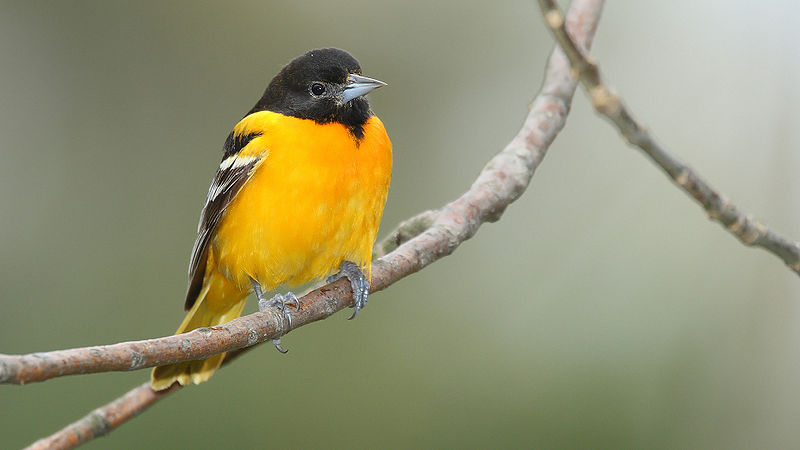
The Baltimore Oriole is a small, blackbird-like bird found in eastern North America. It’s named for the resemblance of its male colors to those on Lord Baltimore’s coat-of-arms from the 17th century.
These birds migrate and breed during springtime and are quite common in their habitats.
Studies have shown that this species interbreeds with western Bullock’s orioles, classifying both as a single species – Icterus galbula.
The males typically have orange feathers along the chest, back, wings and tail while females display tan or yellowish shades instead of bright orange ones like males do.
Both sexes share white wing bars and dark brown eyes, making them easily distinguishable from other birds.
They can often be seen flitting around trees, feeding off nectar buds or insects such as grasshoppers & caterpillars they catch while flying around.
Scientific classification:
| Kingdom | Animalia |
| Phylum | Chordata |
| Class | Aves |
| Order | Passeriformes |
| Family | Icteridae |
| Genus | Icterus |
| Species | I. galbula |
3. Icterids
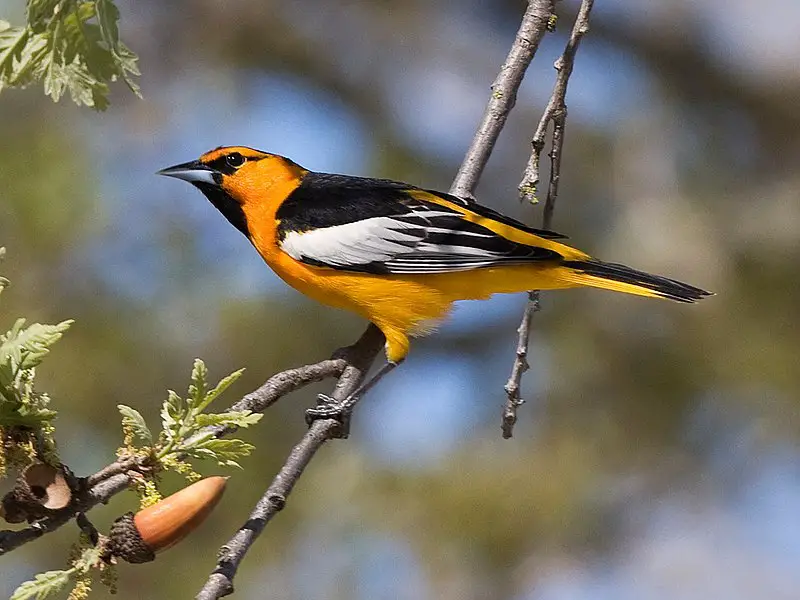
Icterids are a family of small to medium-sized, often colorful New World passerine birds. They have black as their predominant plumage color, with yellow, orange, or red adding vibrancy and life.
Their sizes range greatly in shape and behavior, making them unique amongst other bird species.
The name Icterid comes from the Latin word ‘ictericus’, which means jaundiced ones – referring to the prominent yellow coloring found on some of these birds’ feathers.
These beautiful creatures can be seen flying around many different parts of South America where they live with their young for most part of the year before migrating northwards during fall season.
Scientific classification:
| Kingdom | Animalia |
| Phylum | Chordata |
| Class | Aves |
| Order | Passeriformes |
| Superfamily | Emberizoidea |
| Family | Icteridae Vigors, 1825 |
4. New World Orioles
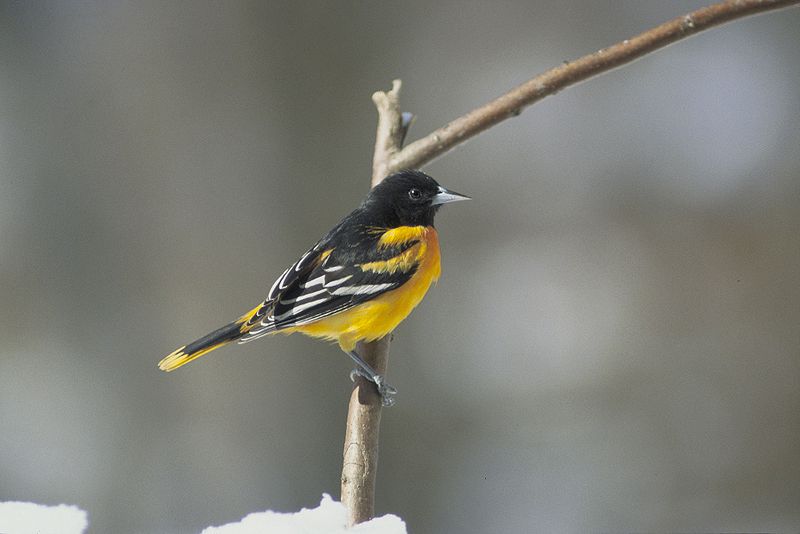
New World orioles are a group of birds belonging to the blackbird family. They share many features with Old World orioles, including size, diet and behaviour; however they differ in their striking plumage.
Males have bright yellow or orange bodies with contrasting black wings and white markings on the head and breast.
Females and immature birds tend to be duller colors, such as browns and greys. These colorful songbirds feed primarily on fruit, insects, nectar from flowers, or sap from trees – sometimes even raiding other nests for eggs.
Their cheerful chirps can often be heard throughout parks during summertime months.
Scientific classification:
| Kingdom | Animalia |
| Phylum | Chordata |
| Class | Aves |
| Order | Passeriformes |
| Family | Icteridae |
| Genus | Icterus Brisson, 1760 |
5. American Redstart
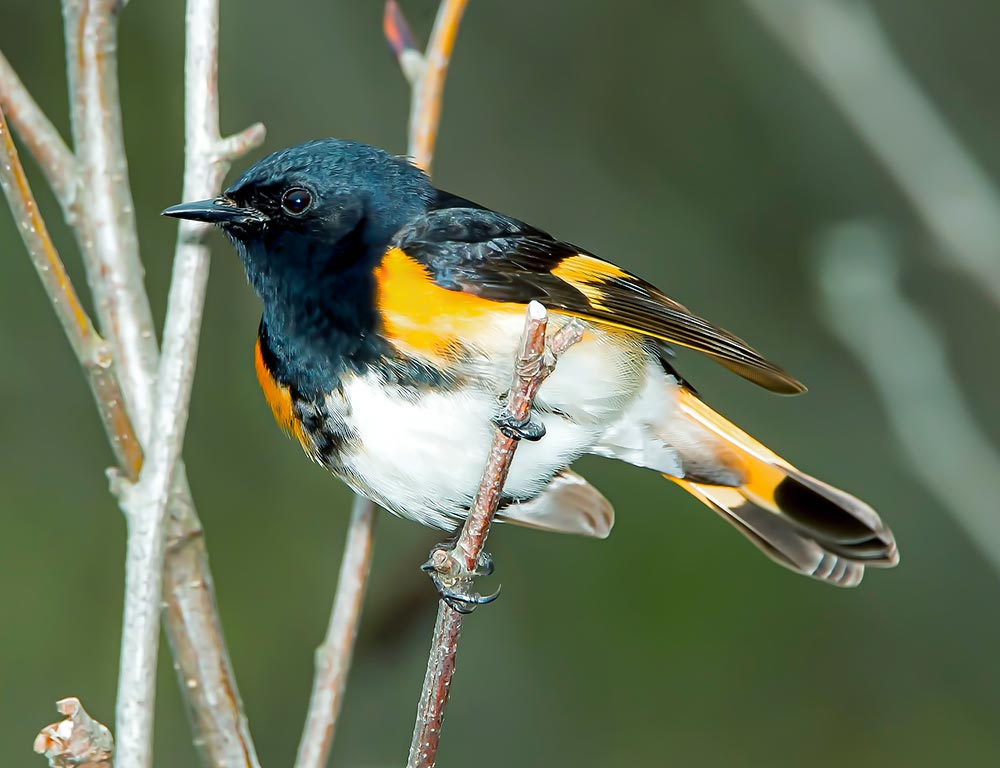
The American Redstart is a beautiful New World Warbler, first documented by Carl Linnaeus in 1758. An elegant black and orange plumage sets it apart from other birds.
The genus Setophaga comes from the Ancient Greek words ‘sēs,’ meaning moth, and ‘pages,’ which means eating, referencing its insect-eating habits. Its song is joyful, with short repeating phrases making up their melodic tune.
They are mostly found hopping around trees on their long legs during breeding season but migrate to Central America for winter months when food sources become scarce in North America.
Scientific classification:
| Kingdom | Animalia |
| Phylum | Chordata |
| Class | Aves |
| Order | Passeriformes |
| Family | Parulidae |
| Genus | Setophaga |
| Species | S. ruticilla |
6. Barn Swallow
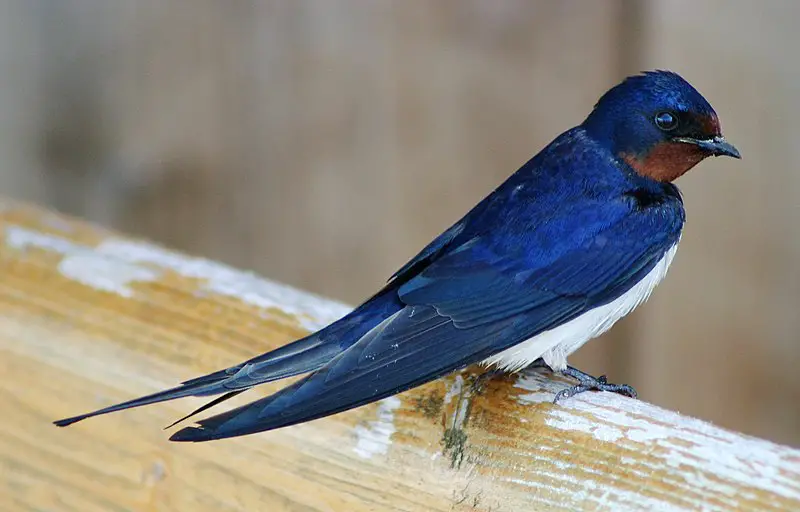
The Barn Swallow is a beautiful passerine bird with blue upperparts and a long, deeply forked tail. Found in Europe, Asia, Africa and the Americas.
It has an astonishingly large natural distribution spanning 251 million square kilometers globally, likely making it one of the world’s most widespread species.
This swallow typically nests near human habitation and other open areas such as fields or grasslands, providing them with suitable invertebrate prey to feed on.
They are insectivorous birds that often fly together in flocks looking for food over rivers or marshes, usually just above tree-top level.
The barn swallow can also be identified by its strong flight consisting of swift, continuous wing beats interspersed with glides during which they hold their wings slightly raised at the shoulders, giving them distinct V-shaped silhouettes in the sky.
Scientific classification:
| Kingdom | Animalia |
| Phylum | Chordata |
| Class | Aves |
| Order | Passeriformes |
| Family | Hirundinidae |
| Genus | Hirundo |
| Species | H. rustica |
7. Red-Breasted Nuthatch

The Red-breasted Nuthatch is a beautiful and vocal songbird that can be found in coniferous forests across Canada, Alaska, the northeastern United States and western US.
This small bird has blue-grey upperparts with cinnamon underparts, a white throat and face with black eye stripe, straight grey bill and black crown.
Its call sounds like a tin trumpet; it’s high-pitched yet nasal.
During mating season they form monogamous pairs to build their nest near tree trunks or branches at low heights off the ground where they lay 2 – 8 eggs at once.
They are very active little birds who love clinging to trees while searching for insect larvae or seeds within the bark of trees, which helps control pest populations.
Scientific classification:
| Kingdom | Animalia |
| Phylum | Chordata |
| Class | Aves |
| Order | Passeriformes |
| Family | Sittidae |
| Genus | Sitta |
| Species | S. canadensis |
8. Orchard Oriole
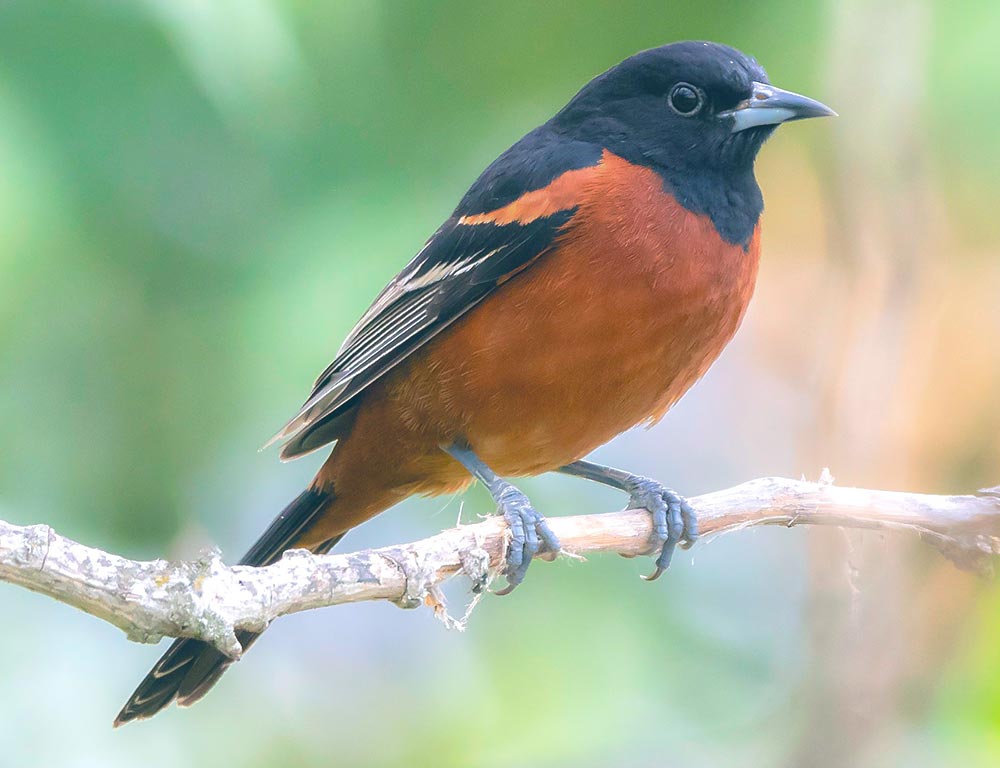
The Orchard Oriole is a small species of icterid bird, with the subspecies I. s. fuertesi sometimes considered its own separate species known as the Ochre or Fuertes’ Oriole.
The adult male of the nominate subspecies has chestnut upperparts and black wings and tail, while females are more yellowish-green in coloration on their back and wings.
Its bill is pointed, black in color, with some blue-gray at the base of its lower mandible.
This beautiful bird can also be found across North America during migration season; they inhabit woodlands near streams or rivers to breed before migrating south for winter months.
Scientific classification:
| Kingdom | Animalia |
| Phylum | Chordata |
| Class | Aves |
| Order | Passeriformes |
| Family | Icteridae |
| Genus | Icterus |
| Species | I. spurius |
9. Eastern Towhee
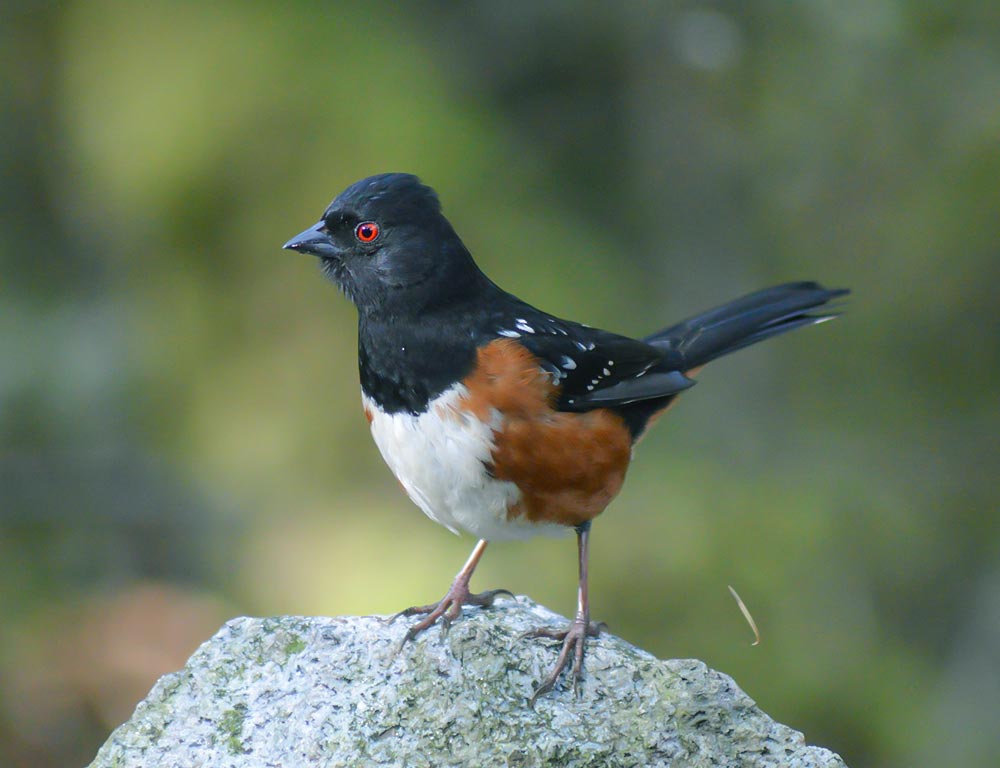
The Eastern Towhee is a large New World sparrow, native to brushy areas of eastern North America. These birds have distinct black and white markings, with chestnut brown underparts.
They nest either low in bushes or on the ground beneath shrubs. Northern towhees are known for migrating south during the winter months.
In recent decades, taxonomy debates have left some questioning whether this bird should remain its own species or be grouped together with the Spotted Towhee as one species – The rufous-sided Towhee.
This lively songbird is bubbly and can often hop around on branches looking for food, such as insects, fruits, and seeds.
Scientific classification:
| Kingdom | Animalia |
| Phylum | Chordata |
| Class | Aves |
| Order | Passeriformes |
| Family | Passerellidae |
| Genus | Pipilo |
| Species | P. erythrophthalmus |
10. Blackburnian Warbler
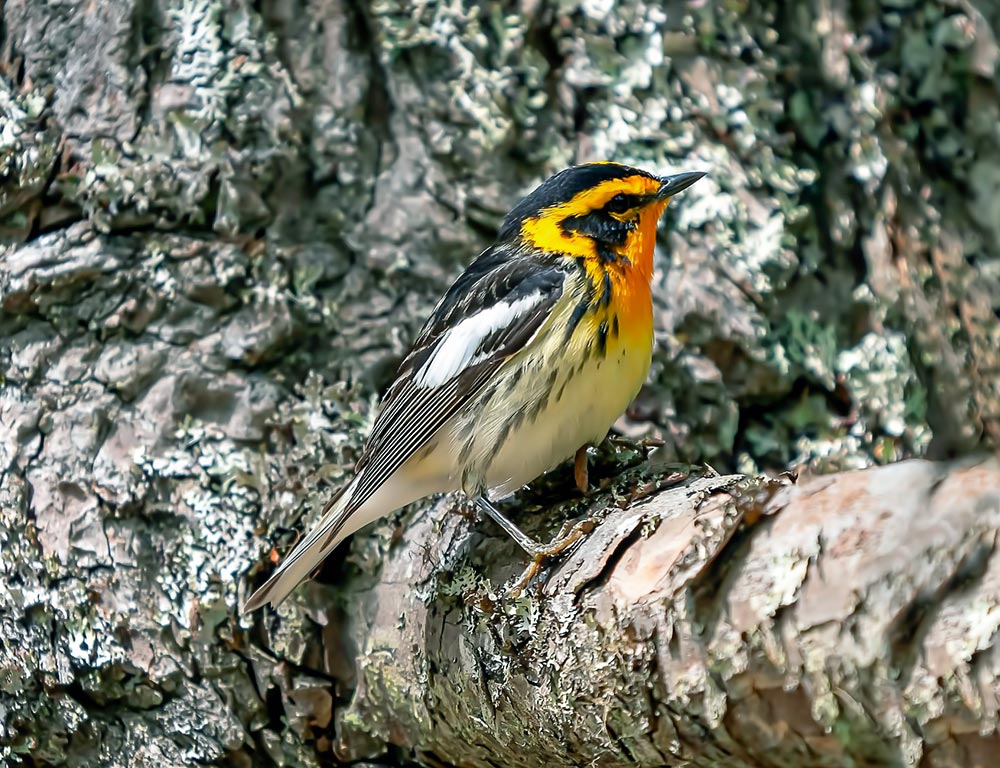
The Blackburnian warbler (Setophaga fusca) is a small New World songbird found primarily in eastern North America.
These birds breed from southern Canada down to the Carolinas and as far west as the Canadian Prairies, Great Lakes region, and New England.
They are migratory birds, spending their winters in Central America or South America; they have also been recorded rarely in Western Europe.
The males of this species can be identified by their bright orange-red throat patches set against yellow head feathers.
Females may show some yellowish colouration but lack the distinct markings seen on male specimens.
This species feeds mainly on insects gleaned from tree branches during its breeding period; during migration it will eat fruit or nectar for sustenance instead
scientific classification:
| Kingdom | Animalia |
| Phylum | Chordata |
| Class | Aves |
| Order | Passeriformes |
| Family | Parulidae |
| Genus | Setophaga |
| Species | S. fusca |
11. Black-Headed Grosbeak
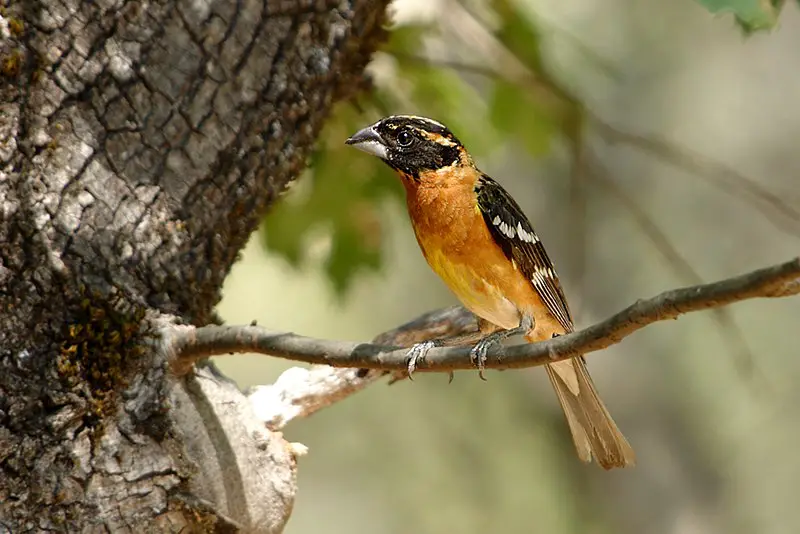
The Black-headed Grosbeak is a medium-sized bird that belongs to the Cardinalidae family. It has black head and upperparts, while its underparts are bright yellow.
This striking contrast makes it easy to distinguish from other birds. The grosbeak typically measures 19 cm in length and weighs around 47 grams.
During summer months, they migrate northward up into southwestern British Columbia for nesting grounds, where they can find plenty of seeds as food sources.
They also hybridize with Rose-breasted Grosbeaks on the Great Plains in America, creating even more colorful plumage variations amongst these species.
This beautiful songbird will make an excellent addition to any backyard or garden if you’re lucky enough to spot one.
Scientific classification:
| Kingdom | Animalia |
| Phylum | Chordata |
| Class | Aves |
| Order | Passeriformes |
| Family | Cardinalidae |
| Genus | Pheucticus |
| Species | P. melanocephalus |
12. Bullock’s Oriole
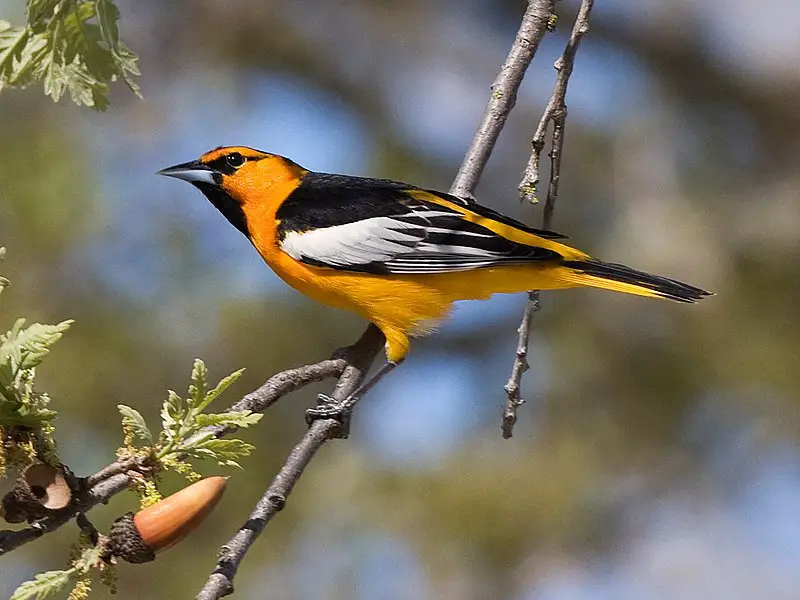
Bullock’s oriole is a small, sexually dimorphic New World blackbird that was once thought to be the same species as the Baltimore Orioles. It was named after William Bullock, an English amateur naturalist.
Male birds are more brightly colored and slightly larger than females. These birds typically have yellow heads and wings with dark brown or black bodies with white bars on their backs and tails.
They can often be seen perched high up in trees, foraging for insects among foliage, or singing from branches during mating season.
Their diet consists mostly of fruits such as oranges, apples, and plums; they also eat some seeds like millet, grasshoppers, and other insects when available.
The Bullock’s oriole is found throughout western North America in areas of woodland scrubland, which provide it shelter from predators while providing plenty of food sources to sustain itself year-round.
Scientific classification:
| Kingdom | Animalia |
| Phylum | Chordata |
| Class | Aves |
| Order | Passeriformes |
| Family | Icteridae |
| Genus | Icterus |
| Species | I. bullockii |
13. Northern Cardinal

The Northern Cardinal is a beautiful bird, easily identified by its bright red plumage. It can be found in the eastern United States from Maine to Minnesota and south through Mexico and Belize.
Along with its striking colouration, it has a distinctive crest on its head and sharp black facial markings around the eyes.
Despite their small size (measuring 7-9 inches), they are very vocal birds – males sing persistently throughout springtime to attract mates or proclaim their territory.
They typically feed on insects, seeds and fruits but also enjoy suet at backyard bird feeders.
The female is less brightly coloured than her mate but still stands out among other songbirds due to her warm brownish-red feathers.
Cardinals pair for life, so you may often see them together in your garden or neighborhood park.
Scientific classification:
| Kingdom | Animalia |
| Phylum | Chordata |
| Class | Aves |
| Order | Passeriformes |
| Family | Cardinalidae |
| Genus | Cardinalis |
| Species | C. cardinalis |
14. Varied Thrush
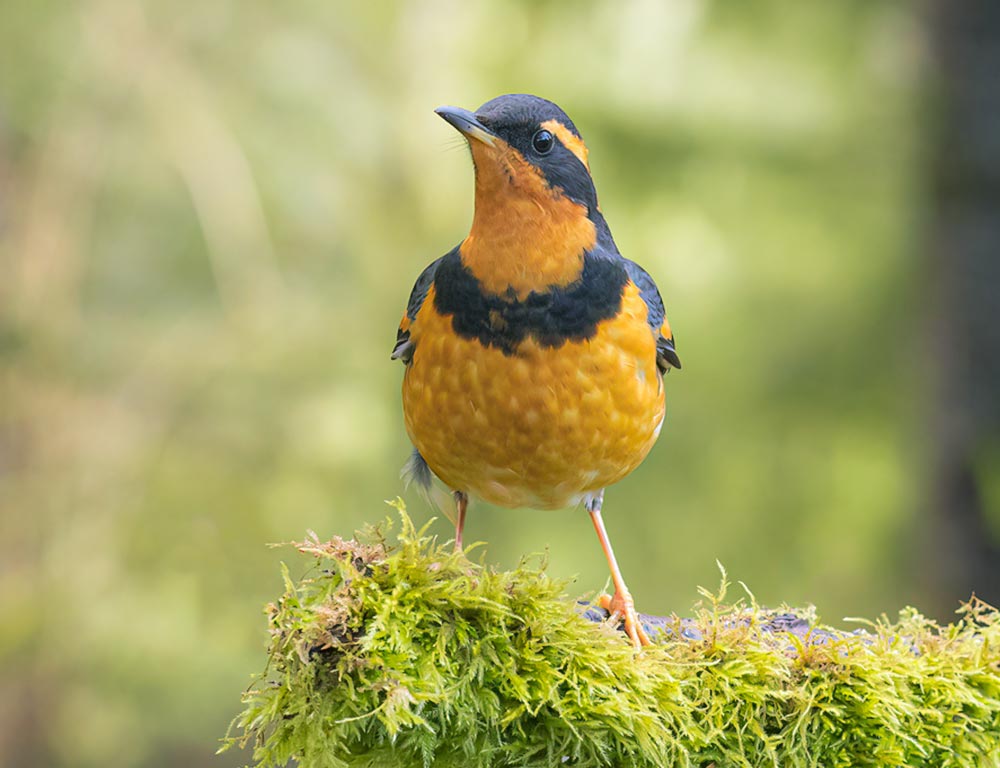
The Varied Thrush (Ixoreus naevius) is the only species in its genus and belongs to the thrush family, Turdidae.
It was first described by German naturalist Johann Friedrich Gmelin in 1789 as Turdus naevius, based on a specimen owned by John Latham, which had been described as “Spotted Thrush” four years earlier.
This bird has an olive-brown back with reddish streaks along white underparts; it also bears spots of yellow or orange colouring across its chest.
Its wings are black with bold white patches, while its tail appears long and pointed at times when spread out during flight.
The varied thrush can be found throughout western North America from Alaska southwards into California, Arizona, New Mexico, and northern Mexico, where they prefer habitats such as coniferous forests and mountain areas near streams or rivers for their habitat.
They feed mainly on insects but will also eat fruits if available making them omnivorous birds.
Scientific classification:
| Kingdom | Animalia |
| Phylum | Chordata |
| Class | Aves |
| Order | Passeriformes |
| Family | Turdidae |
| Genus | Ixoreus Bonaparte, 1854 |
| Species | I. naevius |
15. Scarlet Tanager

The Scarlet Tanager is a beautiful medium-sized bird found in parts of North and South America. It belongs to the Cardinal family, and has striking red plumage with black wings and tail feathers.
Its song is similar to other cardinals yet also unique in its own way – it’s recognizable by its high whistles that become lower towards the end.
The species feeds mainly on insects as well as berries from trees or shrubs during breeding season, when they may form loose flocks over open woodlands foraging for food.
They are highly territorial birds during nesting season which happens between April and June each year; both males and females fiercely defend their nests against intruders such as cats or squirrels.
Scientific classification:
| Kingdom | Animalia |
| Phylum | Chordata |
| Class | Aves |
| Order | Passeriformes |
| Family | Cardinalidae |
| Genus | Piranga |
| Species | P. olivacea |
16. Hooded Oriole
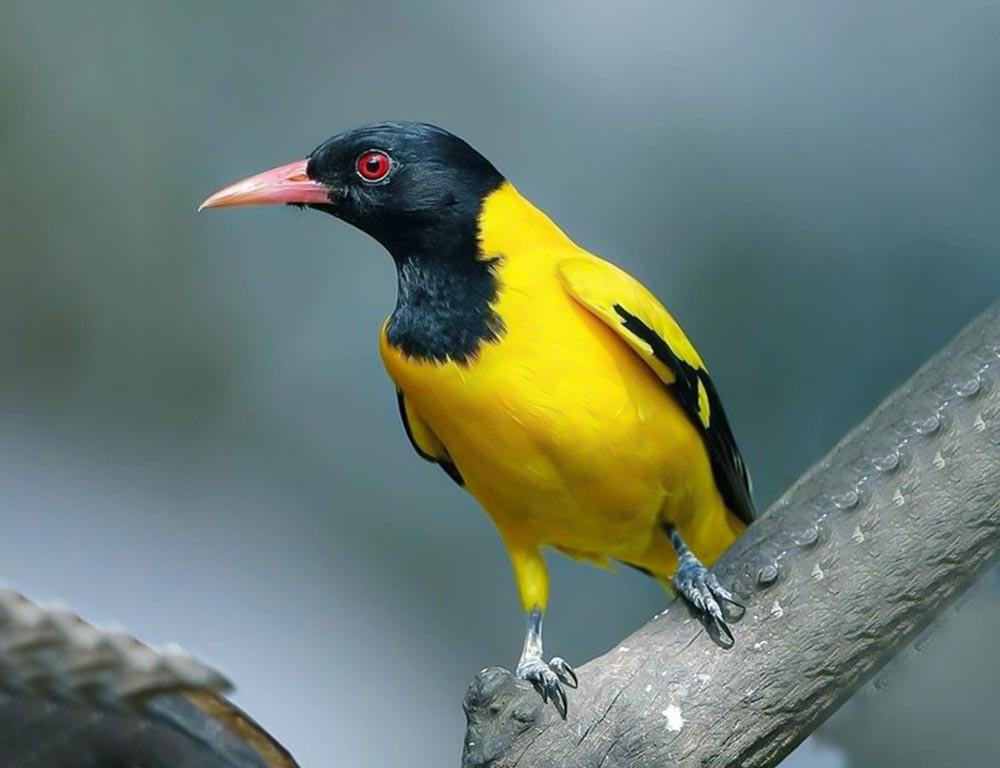
The Hooded Oriole is a medium-sized New World bird with bright, vibrant colours. The male has an orange to yellow body and black back, face, tail and bib.
Its wings have two white bars that stand out against the dark feathers surrounding it. The female has more olive coloration but also has some yellow accents.
Both sexes have a curved bill, which is completely black in color, and white wing bars on their wings for easy identification from other birds in the area.
It typically lives in open woodlands or tropical areas where plenty of trees provide food sources such as insects and fruit for them to eat while they perch amongst their branches during nesting season.
Scientific classification:
| Kingdom | Animalia |
| Phylum | Chordata |
| Class | Aves |
| Order | Passeriformes |
| Family | Icteridae |
| Genus | Icterus |
| Species | I. cucullatus |
17. Rufous Hummingbird
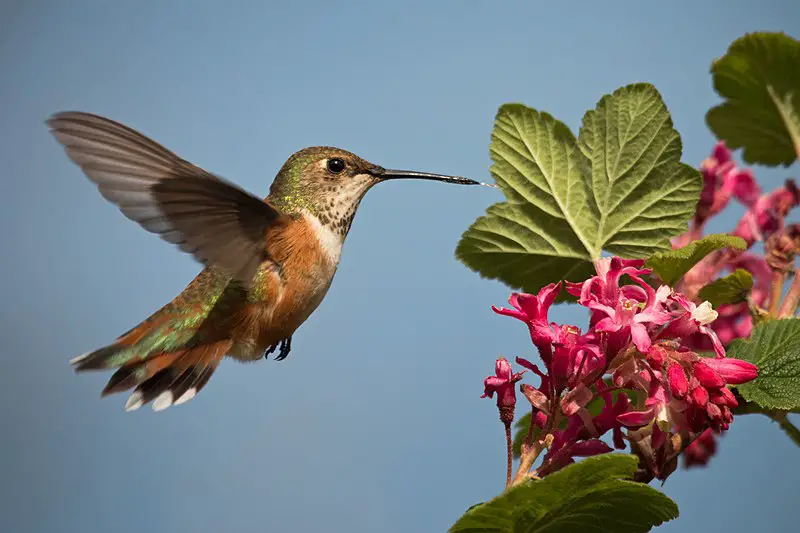
The beautiful Rufous Hummingbird is a small bird of 8 cm in length, with a long slender beak. It stands out due to its extraordinary flight skills and incredible migratory transits- they can fly up to 2,000 miles.
This species was formally described by German naturalist Johann Friedric in 1788 and belongs to the genus Selasphorus.
These birds are found all over North America and parts of Mexico during summertime; while wintering in Central America or northern South America.
They feed on nectar from flowers as well as insects for protein intake. Their vibrant feathers, agile flying abilities, and fascinating life cycle make them an interesting addition to any backyard wildlife habitat.
Scientific classification:
| Kingdom | Animalia |
| Phylum | Chordata |
| Class | Aves |
| Order | Apodiformes |
| Family | Trochilidae |
| Genus | Selasphorus |
| Species | S. rufus |
18. Spot-Breasted Oriole
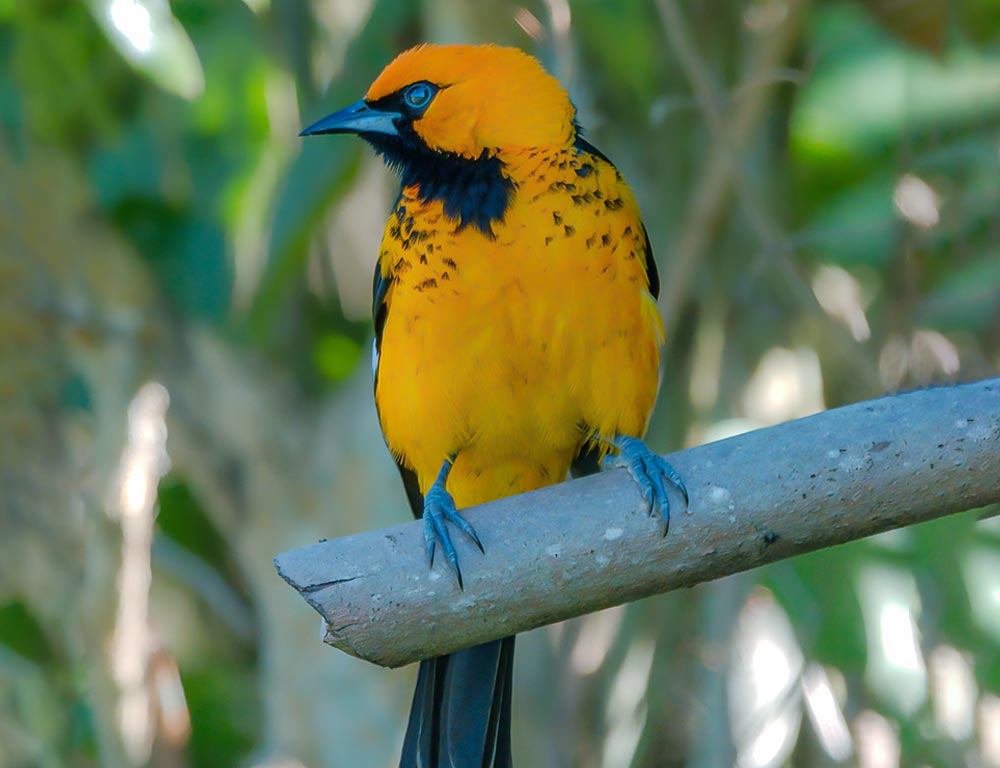
The Spot-breasted Oriole is a stunningly beautiful bird, with its bright orange feathers and black bib. It can be found in Central America from Mexico to Panama, including much of the Caribbean region.
The male and female share similar plumage; however, females are olive green on their back and tail instead of orange like males. Juveniles also lack most or all of the black coloring on their face and throat.
This mid-sized songbird loves open woodlands near water sources such as rivers or streams where it can feed off insects for sustenance. Its distinctive call also makes it easy to spot if you’re out looking for birds.
Scientific classification:
| Kingdom | Animalia |
| Phylum | Chordata |
| Class | Aves |
| Order | Passeriformes |
| Family | Icteridae |
| Genus | Icterus |
| Species | I. pectoralis |
19. Altamira Oriole
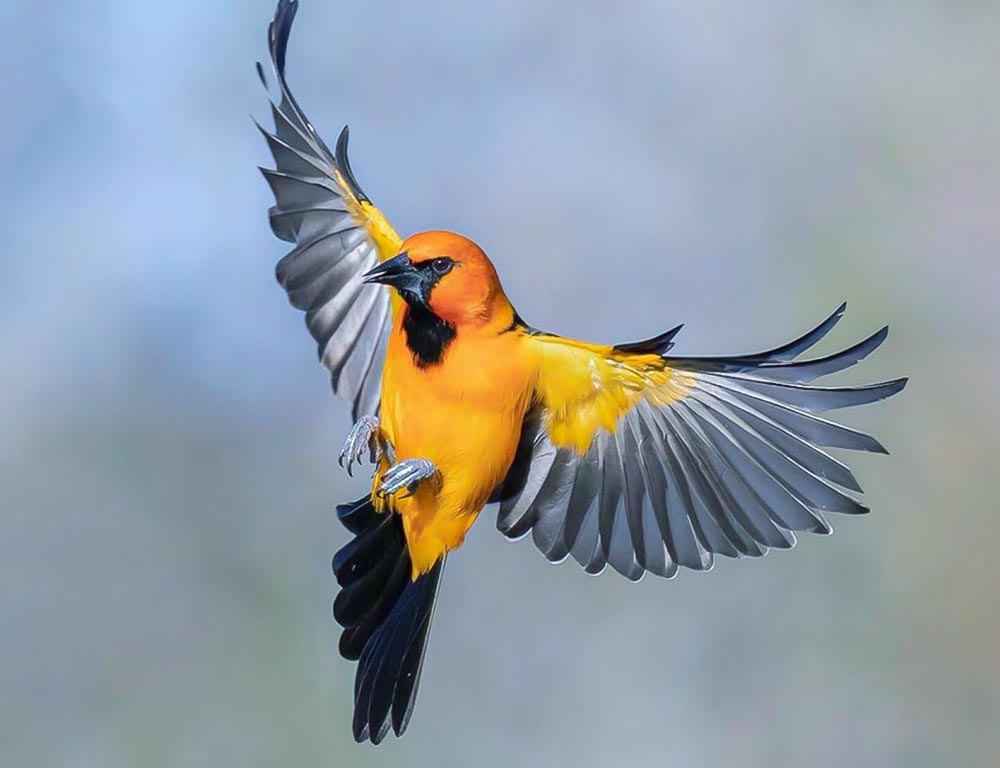
The Altamira oriole is a New World species found in subtropical lowlands from the Mexican Gulf Coast to northern Central America, and inland as well. It was only recently spotted in southern Texas since 1939.
This bird stands out among its genus for being the largest at 25cm (9.8in) and 56g (2oz). Its preferred habitat is open woodland where it builds nests made of plant fibers and animal hair lined with grasses or mosses.
Adults have black heads, wings and tails while their chests are orange-yellow with white markings on each side; juveniles display more yellowish plumage than adults do.
They feed mainly on insects but also occasionally eat fruits or nectar depending on what’s available during certain seasons.
Scientific classification:
| Kingdom | Animalia |
| Phylum | Chordata |
| Class | Aves |
| Order | Passeriformes |
| Family | Icteridae |
| Genus | Icterus |
| Species | I. gularis |
20. Western Tanager
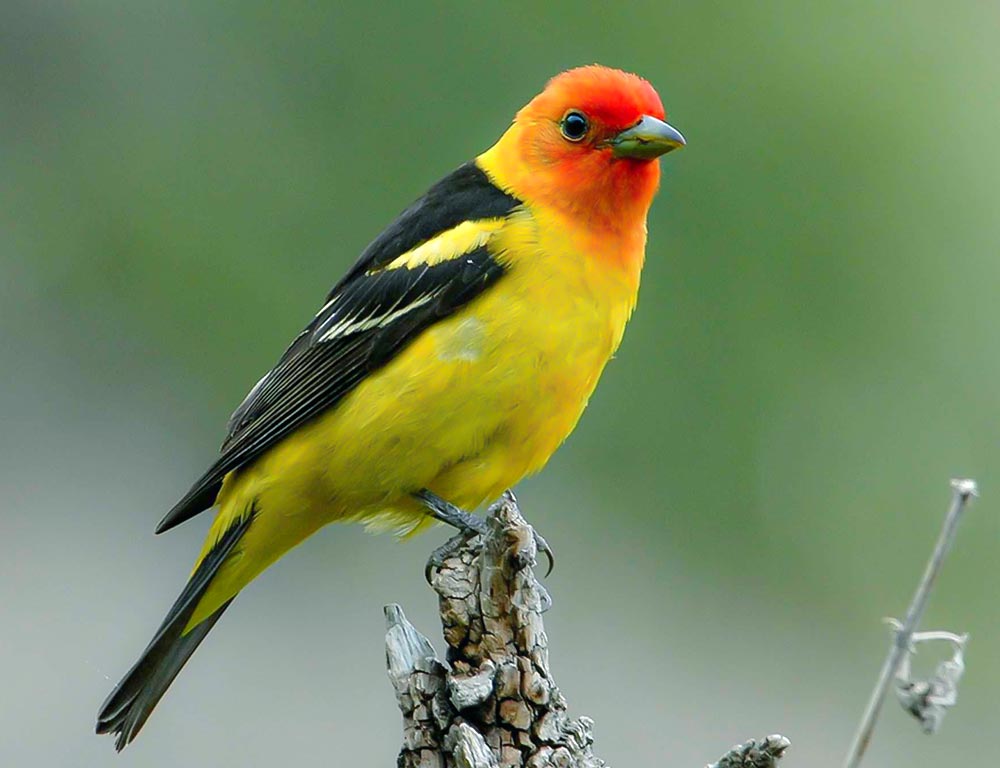
The Western Tanager (Piranga ludoviciana) is a medium-sized songbird from the cardinal family Cardinalidae. It was illustrated and formally described by American ornithologist Alexander Wilson in 1811.
The species has distinctive plumage, including yellow feathers on its wings and tail, red shoulders, and a black head with a white forehead patch and grayish underparts.
Its vocalizations are also very similar to other members of the cardinal family – they have a high pitched ‘tsee’ note followed by several sweeter notes that come together as parts of complex songs.
They primarily feed on fruit but will also take insects when available for extra protein during breeding season.
These beautiful birds can be found throughout western North America from Alaska down through Mexico making them an iconic part of many landscapes.
Scientific classification:
| Kingdom | Animalia |
| Phylum | Chordata |
| Class | Aves |
| Order | Passeriformes |
| Family | Cardinalidae |
| Genus | Piranga |
| Species | P. ludoviciana |
21. Say’s Phoebe
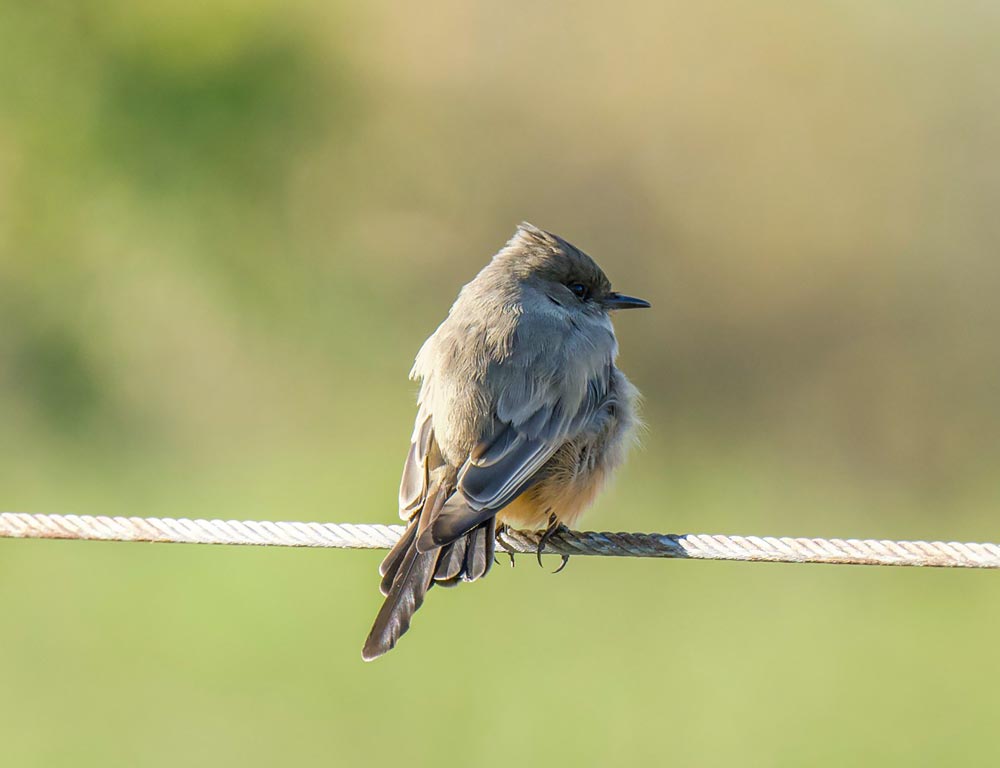
Say’s phoebe is a bird from the tyrant flycatcher family native to western North America. It was named for American naturalist Thomas Say, who first described it in 1825.
This species prefers dry and desolate areas as its habitat. Its brown plumage with whitish underside makes them quite easy to spot among other birds of similar size.
They are also known for their distinctive call; “phoe-bee” which they repeat often throughout the day while perched on fence posts or tree branches scanning their surroundings looking out for food sources such as flying insects, small frogs and lizards etc..
Their nests are made up of plant materials like grasses lined with hair or feathers placed inside cavities either under overhangs or in abandoned structures like barns and sheds providing ample protection against predators such as hawks and foxes.
Scientific classification:
| Kingdom | Animalia |
| Phylum | Chordata |
| Class | Aves |
| Order | Passeriformes |
| Family | Tyrannidae |
| Genus | Sayornis |
| Species | S. saya |
22. Allen’s Hummingbird
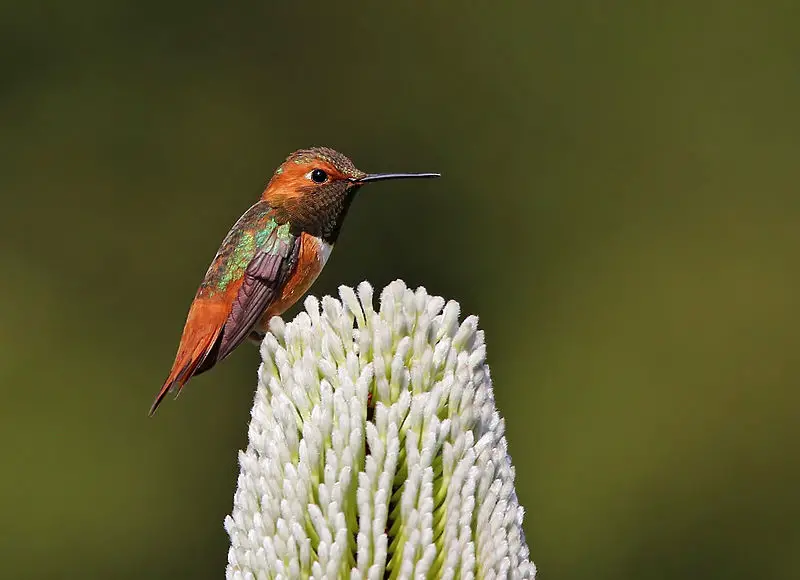
Allen’s Hummingbird is a beautiful species of hummingbird that breeds in the western United States. It stands only 3-3.5 inches long and its stunningly vibrant plumage make it an incredible sight to behold.
The male has a green back and forehead, with rust-colored (rufous) flanks, rump, and tail while his throat dazzles with an iridescent orange coloration.
Females are similarly colored but lack the colorful throat patch of males.
These birds feed primarily on nectar from flowers such as sagebrush, California fuchsia, or currant bushes, using their long bills and tongues to extract food from deep within them.
They also eat small insects for protein which they capture in flight like other hummingbirds do.
Allen’s Hummingbird can be found near chaparral shrubland during breeding season when wildflowers abound, giving these tiny beauties plenty of sustenance.
Scientific classification:
| Kingdom | Animalia |
| Phylum | Chordata |
| Class | Aves |
| Order | Apodiformes |
| Family | Trochilidae |
| Genus | Selasphorus |
| Species | S. sasin |
23. Northern Red Bishop
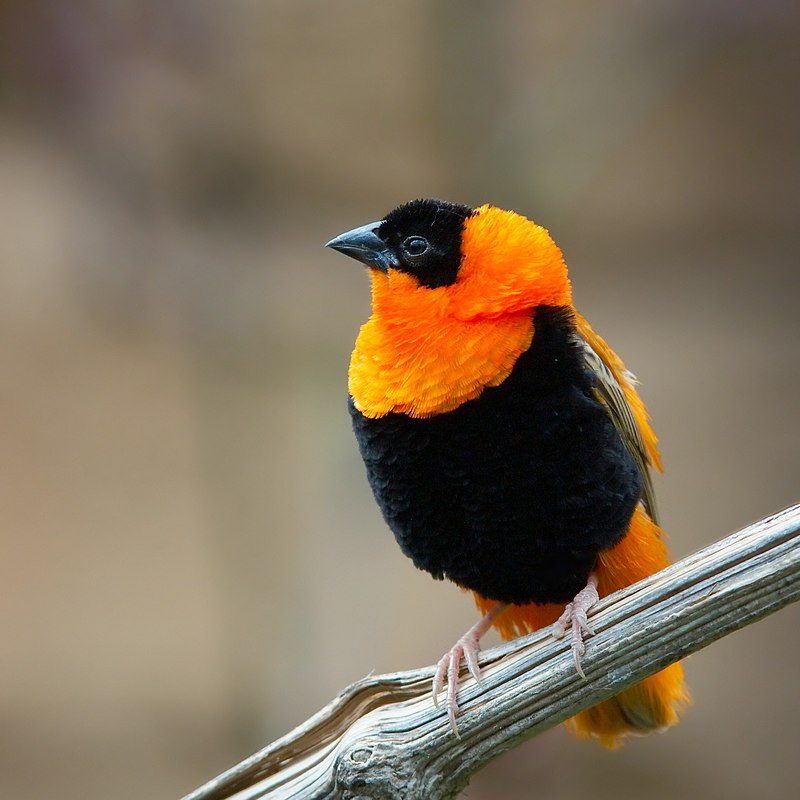
The Northern Red Bishop, part of the Ploceidae family, is a small passerine bird with over sixty species. It can be easily recognized by its bright reddish-orange and black plumage during breeding season.
It has yellow or orange feathers on its wings and tail, with brown upperparts in other seasons.
This species inhabits open grassy areas in southern Africa, such as savannas or wetlands, where they feed mainly on insects, seeds, and grain crops.
They are usually seen alone but form flocks when migrating southwards to avoid cold winter temperatures in their northern ranges.
The Northern Red Bishop is also known for its elaborate courtship displays consisting of flying up high while singing loudly before descending rapidly towards potential mates below them.
Scientific classification:
| Kingdom | Animalia |
| Phylum | Chordata |
| Class | Aves |
| Order | Passeriformes |
| Family | Ploceidae |
| Genus | Euplectes |
| Species | E. franciscanus |
24. Orange-Crowned Warbler
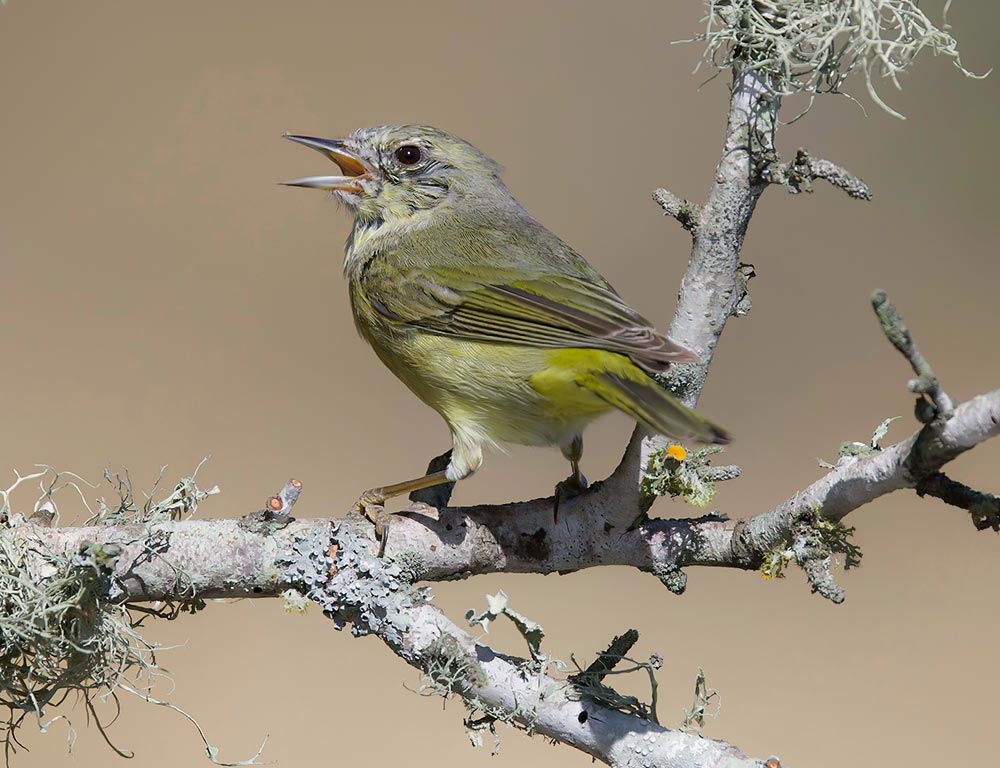
The Orange-crowned Warbler is a small songbird from the New World warbler family. It was formally described in 1822 by Thomas Say, who gave it its scientific name Sylvia celatus – Latin for ‘cloaked’.
This species has an olive green back and wings with yellowish underparts. The males have bright orange crowns during breeding season, which give this bird its namesake.
They can be found mainly in North America but also migrate to Central America during the winter months.
Their diet consists of insects such as butterflies, moths, grasshoppers and beetles; they may also consume fruits occasionally when available.
These birds are relatively quiet except for their mating calls, which include whistles or buzzing sounds that last a few seconds long each time.
The Orange-crowned Warbler is one of the most widespread passerines today due to their hardiness and adaptability; however, there remains the threat of habitat destruction that could affect many populations negatively if not addressed soon enough.
Scientific classification:
| Kingdom | Animalia |
| Phylum | Chordata |
| Class | Aves |
| Order | Passeriformes |
| Family | Parulidae |
| Genus | Leiothlypis |
| Species | L. celata |
25. Flame-Colored Tanager
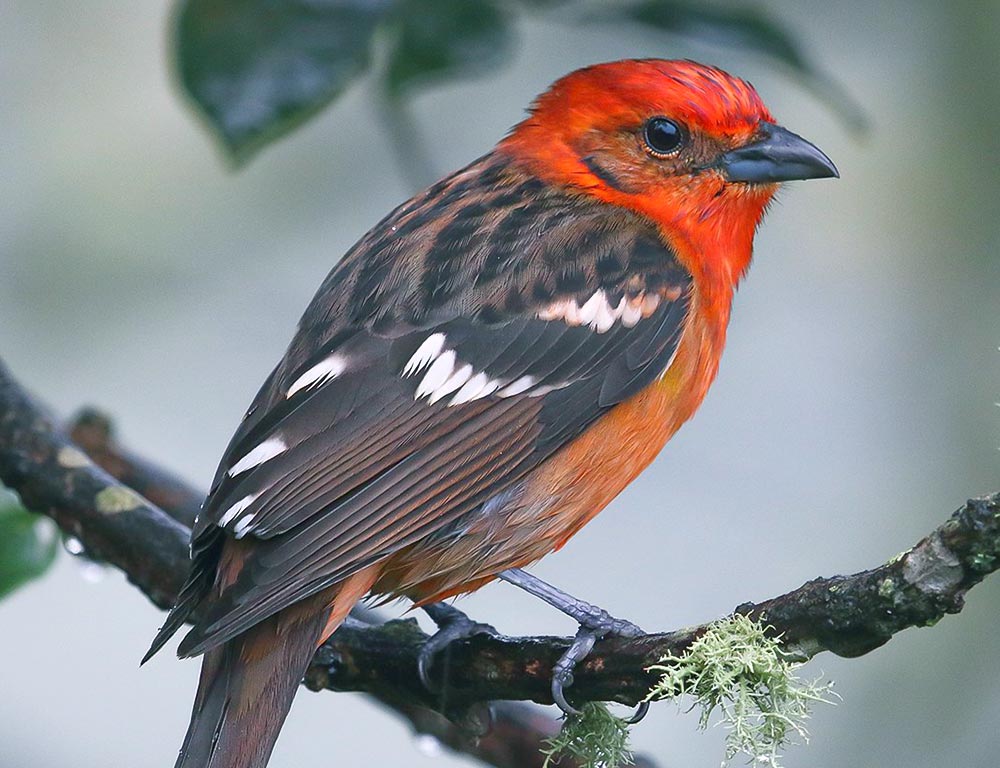
The Flame-colored Tanager is a stunning bird found throughout Central America and Mexico, occasionally straying into the United States.
This medium-sized songbird has a cardinal grosbeak family and measures from 7 to 7.5 inches in length.
Its vibrant colors give it its name. The flame-colored tanager has bright red feathers on its back, wings, and tail, contrasting with an olive-greenish head, neck, and chest.
It also features both white spots along its sides as well as black streaks across each of the wingtips.
The flame-colored tanager loves to feed off insects such as ants while residing in gardens or forests where there are plenty of trees for sheltering purposes.
Scientific classification:
| Kingdom | Animalia |
| Phylum | Chordata |
| Class | Aves |
| Order | Passeriformes |
| Family | Cardinalidae |
| Genus | Piranga |
| Species | P. bidentata |
26. Streak-Backed Oriole
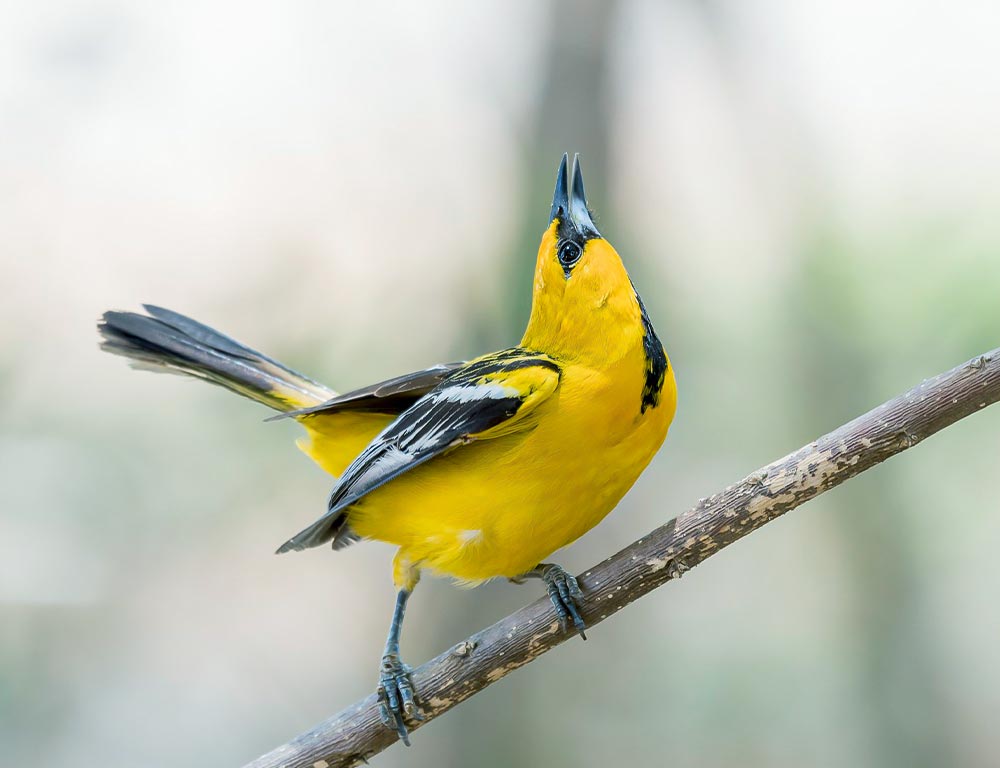
The Streak-backed Oriole is a medium-sized passerine bird belonging to the icterid family. It has an impressive range that extends from Central America and Mexico, all the way up to parts of the United States an occasional visitor.
Commonly found in Costa Rica, Nicaragua, Honduras, El Salvador, and Guatemala it sports orange plumage on its back with black streaks running along its wings and tail feathers.
Its head consists of contrasting colors including yellow eyes surrounded by greyish-white cheeks which meet at a pointed bill colored yellow near its base fading into dark gray towards the tip.
A pale pink line runs over each eye adding further contrast to this visually stunning species of bird.
Scientific classification:
| Kingdom | Animalia |
| Phylum | Chordata |
| Class | Aves |
| Order | Passeriformes |
| Family | Icteridae |
| Genus | Icterus |
| Species | I. pustulatus |
Also Featured In: Yellow New Mexican Birds, Black Birds that Live around United States of America
27. Brambling
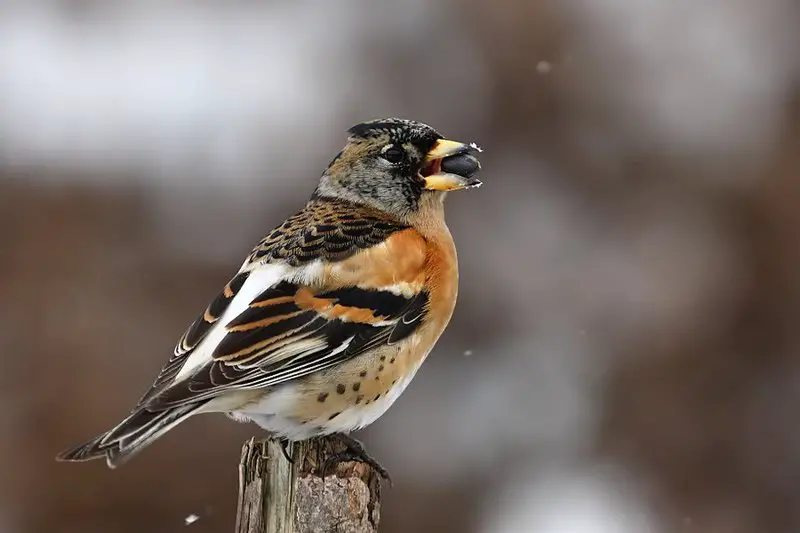
The Brambling is a small passerine bird that belongs to the finch family. It has many names, such as ‘Cock o’ The North’ and ‘Mountain Finch’.
This species is widespread in areas, often seen in flocks during its migration periods.
In 1758 Linnaeus included this species under its current scientific name Fringilla montifringilla, which translates to “mountain fringe”.
Its feathers are mostly black with white markings on their wings and chest area.
They have short beaks used for cracking open seeds while they feed on insects and berries in the summer months; however, they primarily eat grains during winter seasons.
Scientific classification:
| Kingdom | Animalia |
| Phylum | Chordata |
| Class | Aves |
| Order | Passeriformes |
| Family | Fringillidae |
| Subfamily | Fringillinae |
| Genus | Fringilla |
| Species | F. montifringilla |
28. Orange-Bellied Parrot
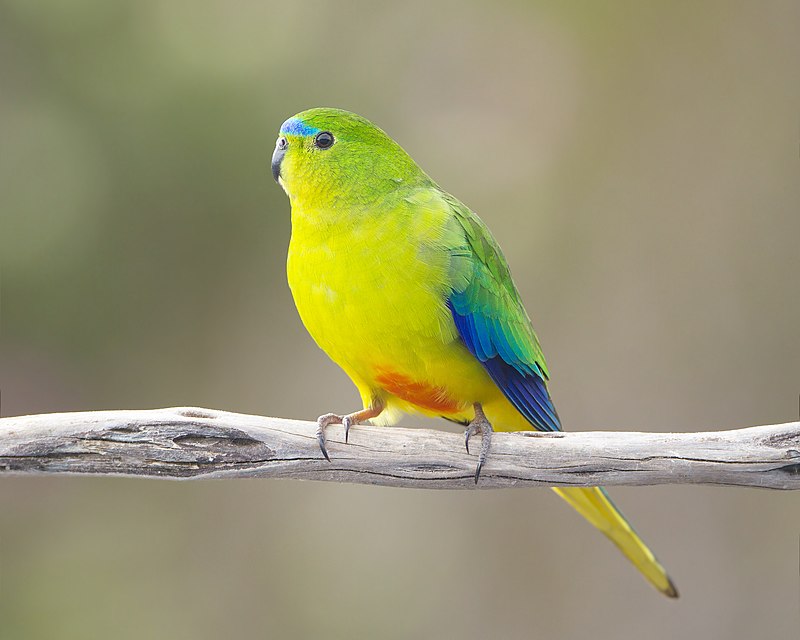
The orange-bellied parrot is a small bird native to Southern Australia, measuring only 8 inches long.
It’s distinguished by its bright grass-green upperparts and yellow underparts with an orange belly patch.
This species of parrot is one of just three that migrate seasonally, usually in flocks ranging from 5 to 50 birds.
During breeding season they inhabit coastal heathland and swamps but spend the rest of their time foraging wetlands further inland or sea coasts along Bass Strait islands.
Sadly, this beautiful little bird has become endangered due to habitat loss and predation, so conservation efforts are being made to protect it before it becomes extinct.
Scientific classification:
| Kingdom | Animalia |
| Phylum | Chordata |
| Class | Aves |
| Order | Psittaciformes |
| Family | Psittaculidae |
| Genus | Neophema |
| Species | N. chrysogaster |
29. European Stonechat
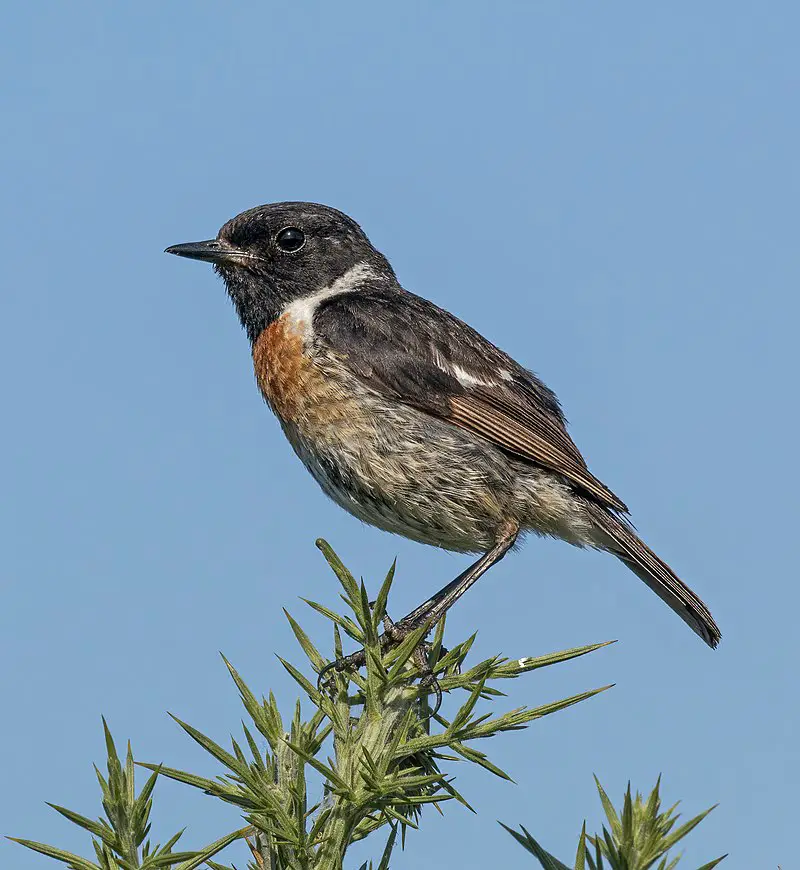
The European stonechat is a small passerine bird belonging to the Old World flycatcher family, Muscicapidae.
It was first described by Swedish naturalist Carl Linnaeus in 1766 and has long been recognized as a subspecies of the common stonechat.
They have dark brown upperparts with black patches on their wings, reddish-orange throats, and breasts with grey coloring on their underside.
Males also have a distinctive white patch near their tail feathers, while females lack this feature and instead possess two whitish spots at each side of their throat area.
These birds are mostly found in open grasslands or scrubland habitats where they feed mainly on insects, although some seed consumption occurs during winter when food becomes scarce.
Scientific classification:
| Kingdom | Animalia |
| Phylum | Chordata |
| Class | Aves |
| Order | Passeriformes |
| Family | Muscicapidae |
| Genus | Saxicola |
| Species | S. rubicola |
Also Featured In: Moorland Birds You Need to Know, Most Popular Birds in Mallorca
30. Western Spindalis
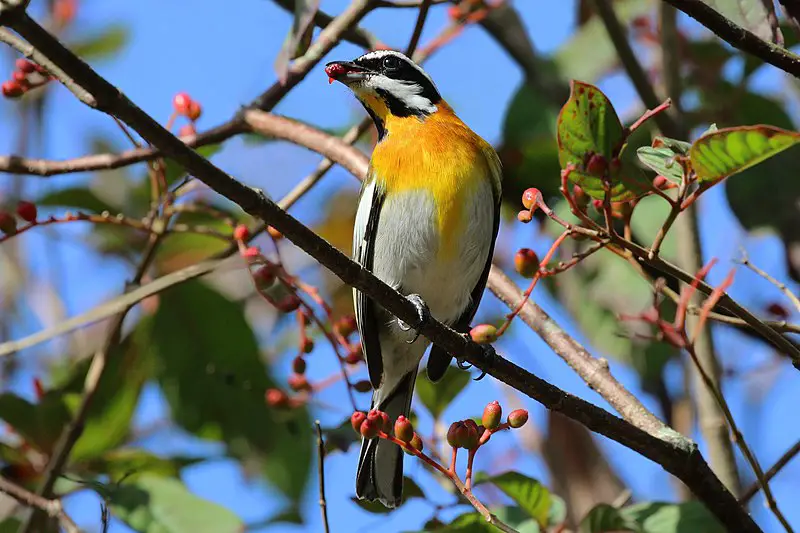
The Western Spindalis is a unique and fascinating species of songbird. It was formerly classified as a stripe-headed tanager, but it has since been reclassified as incertae sedis – that is, its exact place in the avian family tree cannot be determined.
This bird stands out from other birds due to its colorful plumage; males have yellow heads with black streaks across their faces while females are olive green all over with white stripes on the wings and back.
They inhabit tropical forests throughout much of Central America where they feed mainly on fruits and insects.
These birds are agile fliers who often flock together in small groups or pairs when searching for food sources such as mangoes, papayas, figs or even nectar from flowers.
The Western Spindalis makes an interesting addition to any backyard aviary.
Scientific classification:
| Kingdom | Animalia |
| Phylum | Chordata |
| Class | Aves |
| Order | Passeriformes |
| Family | Spindalidae |
| Genus | Spindalis |
| Species | S. zena |
31. Red-Winged Blackbird

The red-winged blackbird is a beautiful bird found in most of North America and Central America.
Its distinct features include a glossy black body, with white shoulder patches and bright red wing coverts year round.
It prefers wetland habitats such as marshes, ponds, lakeshores, and agricultural fields. During breeding season they inhabit grassy areas near water then move south for the winter months.
For food, they mainly eat insects but also consume wild fruit or grains.
They are very social birds often seen in large flocks during migration times when their unmistakable “conk-la-ree” call can be heard echoing across the sky.
Scientific classification:
| Kingdom | Animalia |
| Phylum | Chordata |
| Class | Aves |
| Order | Passeriformes |
| Family | Icteridae |
| Genus | Agelaius |
| Species | A. phoeniceus |
32. Kingfisher
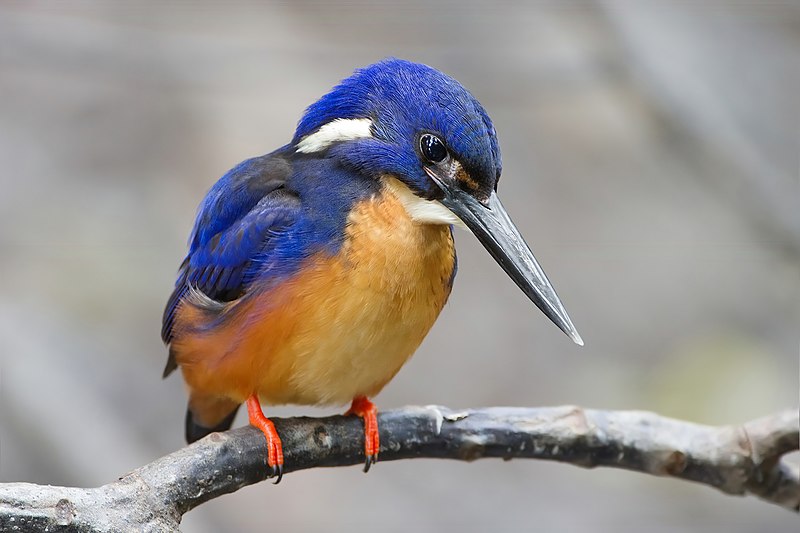
Kingfishers are a vibrant and unique family of birds, with most species found in tropical regions across Africa, Asia, Oceania, and Europe.
Their bright colors make them easily identifiable among the foliage of deep forests near calm ponds or rivers.
They come in three subfamilies: tree kingfishers (Halcyoninae), water kingfishers (Cerylinae), and river kingfishers (Alcedinidae).
Kingfisher birds have short legs used for perching along branches overhanging streams or lakes; they also possess strong beaks perfect for catching fish.
These little hunters will remain motionless as if suspended from thin air until an unsuspecting prey comes within reach.
Then they swoop down quickly to grab their meal. With 116 different species making up this incredible family, there’s something special about every single one.
Scientific classification:
| Kingdom | Animalia |
| Phylum | Chordata |
| Class | Aves |
| Order | Coraciiformes |
| Suborder | Alcedines |
| Family | Alcedinidae Rafinesque, 1815 |
33. Eastern Bluebird
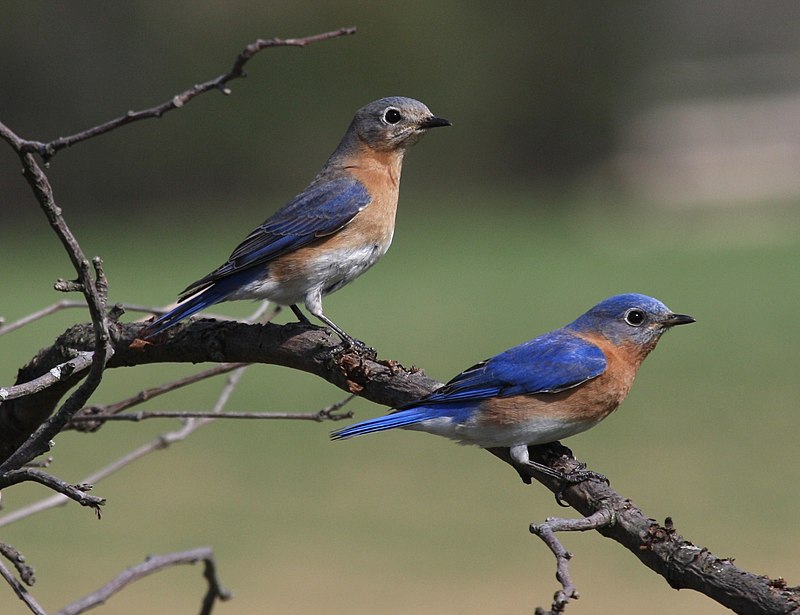
The Eastern bluebird is a small migratory thrush that can be found in open woodlands, farms, and orchards across North America.
The male has bright-blue breeding plumage, which makes it easily recognizable by birders.
It produces melodious songs such as jeew, chir-wi, and chiti WEEW wewidoo.
This popular species was declared the state bird of Missouri back in 1927 due to its beauty and charm.
In addition to being beautiful, these birds are also beneficial for farmers because they eat insects like grasshoppers and beetles which damage crops.
They nest in cavities so providing nesting boxes helps them thrive even more.
With their vibrant colors, sweet melodies, and helpful nature, it’s easy to see why the Eastern Bluebird is beloved worldwide.
Scientific classification:
| Kingdom | Animalia |
| Phylum | Chordata |
| Class | Aves |
| Order | Passeriformes |
| Family | Turdidae |
| Genus | Sialia |
| Species | S. sialis |
34. Guianan Cock-Of-The-Rock
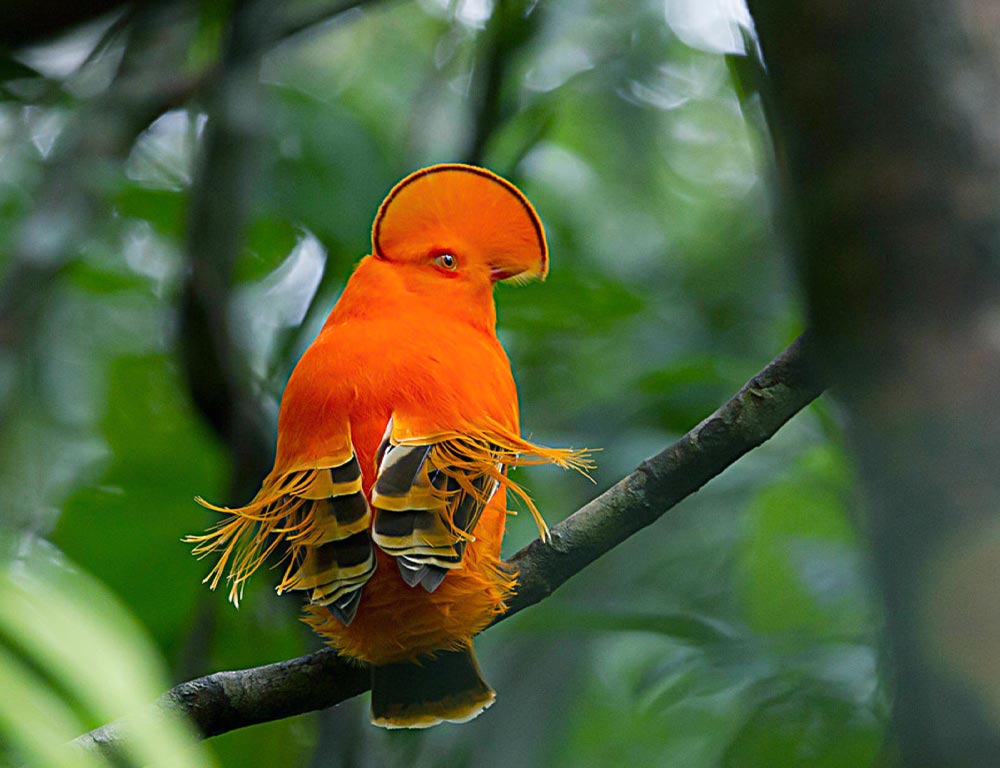
The Guianan cock-of-the-rock is an impressive South American bird, with the male having a striking orange and black plumage.
This cotinga species can be found in tropical rainforests near rocky outcrops, usually measuring about 30 cm (12 in) long and weighing around 200 to 220 g (7.1 to 7.8 oz).
The female’s feathers are brownish/dark smokey grey – generally less noticeable than the males due to their bright colours.
These birds have also been known for their unusual courtship displays involving loud calling and bowing which take place on exposed rocks or branches of tall trees.
Their diet consists mainly of fruits supplemented by invertebrates such as insects, spiders, millipedes and centipedes that they capture while flying through the canopy layer.
All in all, these beautiful creatures will make sure you never forget them after seeing one.
Scientific classification:
| Kingdom | Animalia |
| Phylum | Chordata |
| Class | Aves |
| Order | Passeriformes |
| Family | Cotingidae |
| Genus | Rupicola |
| Species | R. rupicola |
35. Western Bluebird
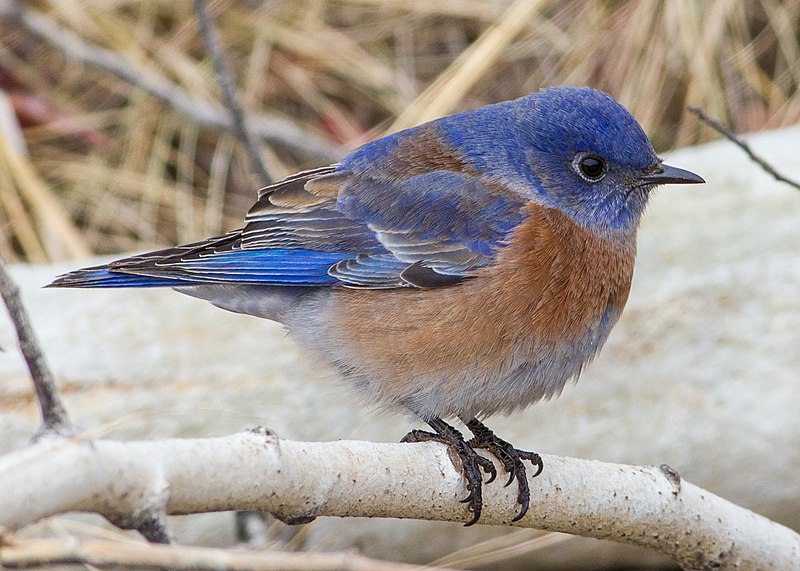
The Western Bluebird is a small North American thrush that was formally described by English naturalist William John Swainson in 1832.
It has six subspecies and measures 15 to 18 cm long, with the adult male being bright blue on top and light orange-brown underneath.
Its wings have white bars which contrast against its bright plumage. The female is duller overall but retains the same wing pattern as its counterpart.
In addition, it also sports an attractive reddish patch near its bill area when breeding season arrives.
This species can be found inhabiting open woodlands, grassy meadows, or agricultural areas of western America from Alaska southwards into Mexico and Guatemala, where they feed mainly on insects such as beetles, flies, ants, etc.
All in all, this gorgeous bird adds color to any environment.
Scientific classification:
| Kingdom | Animalia |
| Phylum | Chordata |
| Class | Aves |
| Order | Passeriformes |
| Family | Turdidae |
| Genus | Sialia |
| Species | S. mexicana |
36. Ruddy Kingfisher
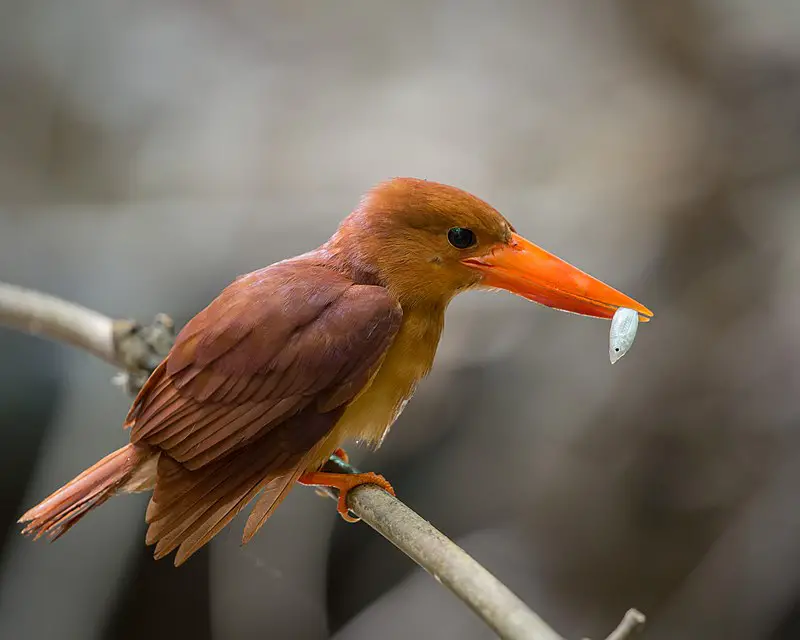
The Ruddy kingfisher is a beautiful species of bird found in east and southeast Asia. It measures up to 25 cm long, with bright red bill and legs that contrast against its rust-red body which deepens into purple at the tail.
There isn’t much sexual dimorphism between male and female birds, although some sources report males being brighter plumage than females.
These birds usually inhabit coastal mangrove forests or riverine habitats where they feed on aquatic insects like dragonflies as well as small fish.
They are typically solitary but may form pairs during breeding season when their loud calls can be heard from afar.
Scientific classification:
| Kingdom | Animalia |
| Phylum | Chordata |
| Class | Aves |
| Order | Coraciiformes |
| Family | Alcedinidae |
| Subfamily | Halcyoninae |
| Genus | Halcyon |
| Species | H. coromanda |
37. Common Redstart
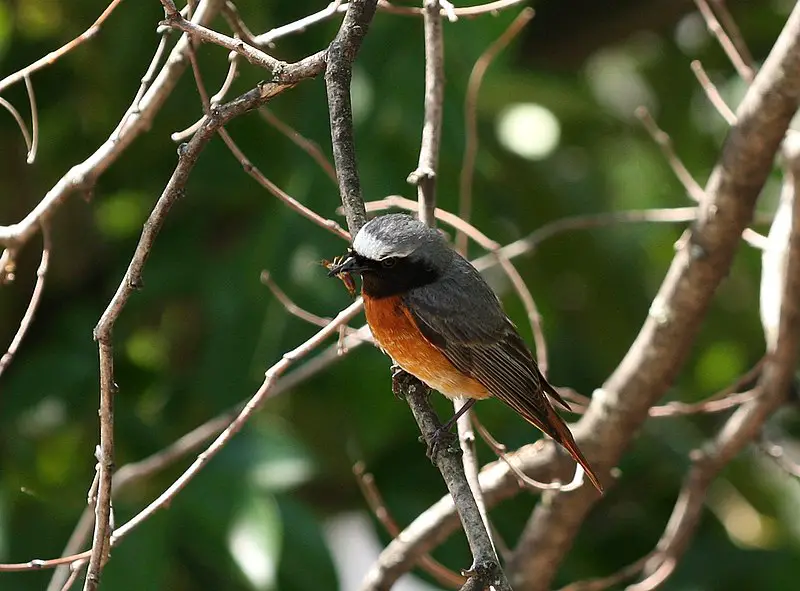
The Common Redstart is a small passerine bird found in the Phoenicurus genus. It was once classified as part of the thrush family but it has since been identified as an Old World flycatcher.
The species was first formally described by Swedish naturalist Carl Linnaeus in 1758 and is known for its predominantly reddish-orange plumage, hence its name red start.
This beautiful little bird inhabits open woodlands across Europe, Asia and northern Africa where they feed on insects such as flies, moths and beetles which they catch while flying or hovering over vegetation with their wings spread out like fans.
They also enjoy consuming fruits when available during autumn months – making them a welcome visitor to any garden.
These birds are aesthetically pleasing and beneficial to local ecosystems due to their diet of insect pests that can be harmful to plants.
Scientific classification:
| Kingdom | Animalia |
| Phylum | Chordata |
| Class | Aves |
| Order | Passeriformes |
| Family | Muscicapidae |
| Genus | Phoenicurus |
| Species | P. phoenicurus |
Also Featured In: Belarus Birds You Should Know, Common Slovakian Birds
38. Eurasian Bullfinch
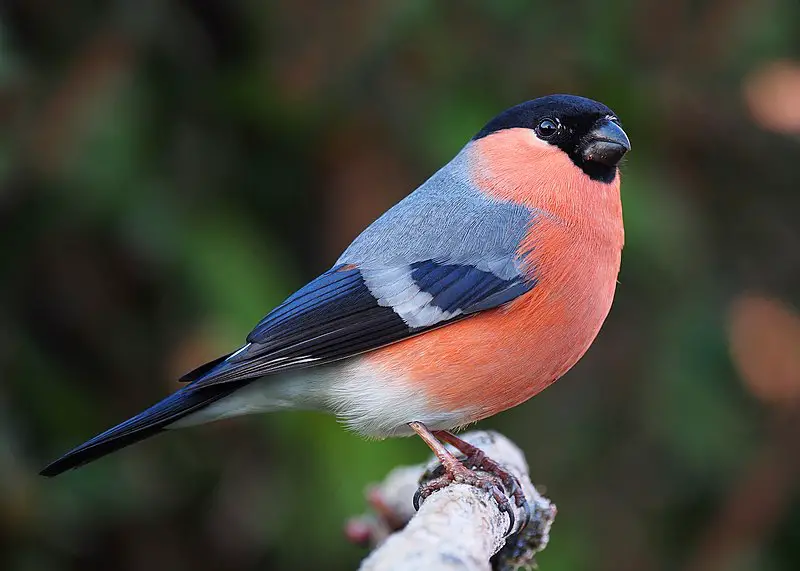
The Eurasian Bullfinch is a small bird found in the finch family, Fringillidae. It has an unmistakable appearance with its plump body and bright pink chest.
Its head is grayish-brown while its wings are black with white edging along the tips of some feathers. The tail is also black-tipped with white or yellowish edges.
They inhabit open woodlands and gardens throughout Europe, North Africa, parts of Asia and western Siberia in search of food such as berries, buds or insects which they feed on during winter months when other sources become scarce.
These birds form monogamous pairs to breed each year between March through August where both parents incubate their eggs during this time until hatching around mid-May.
Usually producing two broods per season if conditions are favorable for nesting success.
Scientific classification:
| Kingdom | Animalia |
| Phylum | Chordata |
| Class | Aves |
| Order | Passeriformes |
| Family | Fringillidae |
| Subfamily | Carduelinae |
| Genus | Pyrrhula |
| Species | P. pyrrhula |
39. American Woodcock
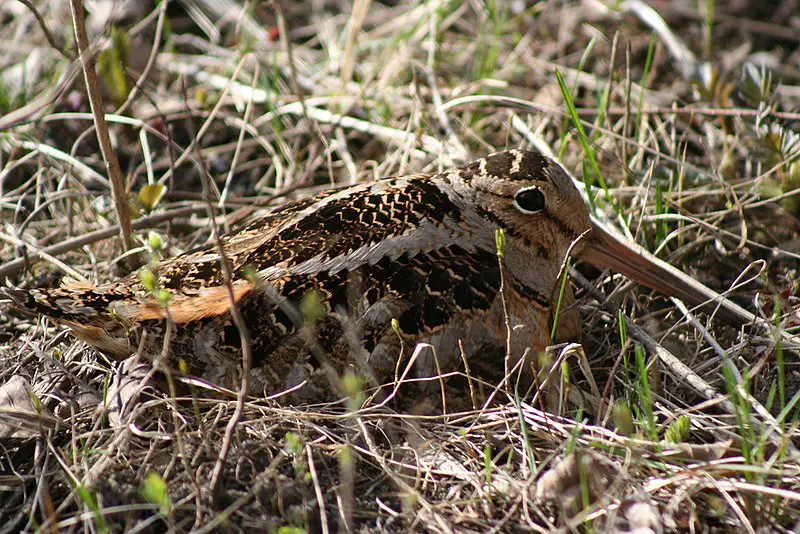
The American woodcock is a small shorebird found mainly in the eastern half of North America. It has brown, black and grey plumage which helps it blend into its brushy, young-forest habitats perfectly.
Often referred to as the timberdoodle or bogsucker due to its quirky behavior, these birds are normally solitary and spend their time foraging on the ground for food like worms and insects.
During mating season males perform an elaborate courtship ritual involving loud calls from atop tall perches followed by graceful dives towards earth while singing songs along the way.
The female then selects her mate based solely upon his performance during this ritual display.
All in all, this bird is truly amazing, with a unique appearance and interesting behaviors that have made them quite popular among ornithologists worldwide.
Scientific classification:
| Kingdom | Animalia |
| Phylum | Chordata |
| Class | Aves |
| Order | Charadriiformes |
| Family | Scolopacidae |
| Genus | Scolopax |
| Species | S. minor |
40. Black-Vented Oriole
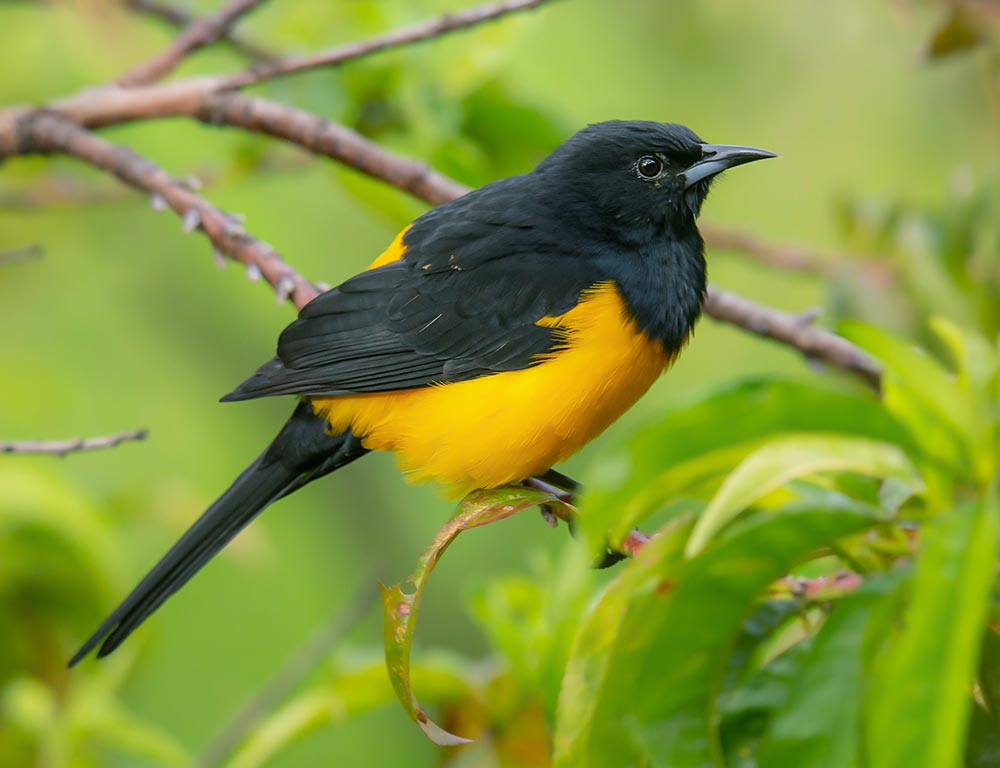
The Black-vented oriole is a striking bird species found in El Salvador, Guatemala, Honduras, Mexico, Nicaragua, and the United States. It has black upperparts with yellow underparts and white wing spots on its wings.
The male also has an orange head patch, while females have brown heads. This species prefers to live in dry or moist forests ranging from lowland to montane elevations.
They feed mainly on insects but may also eat some fruit, such as berries or figs, when available during certain times of the year.
As they are quite active birds, they require plenty of space, which makes them ideal for larger aviaries if kept as pets.
Scientific classification:
| Kingdom | Animalia |
| Phylum | Chordata |
| Class | Aves |
| Order | Passeriformes |
| Family | Icteridae |
| Genus | Icterus |
| Species | I. wagleri |
41. Orange Fruit Dove
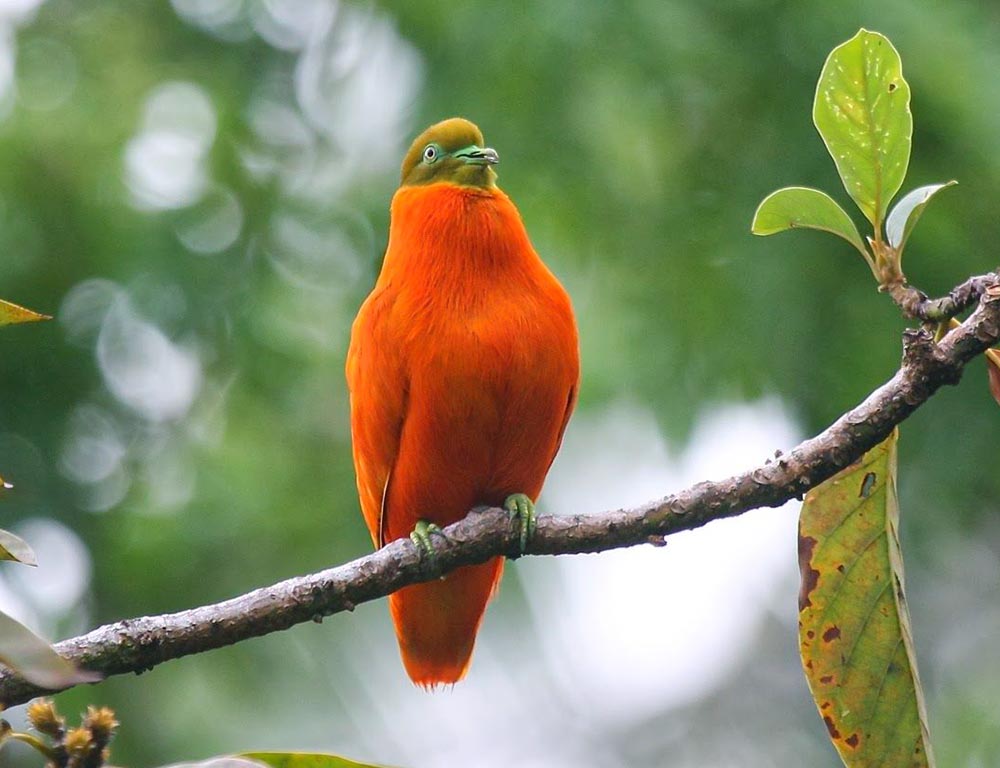
The Orange Fruit Dove is a stunningly colorful pigeon species in the Columbidae family. The male has an olive green head and bright orange body feathers that look like hair when perched.
Its legs, bill, and skin around its eyes are bluish-green, while its iris is whitish. In contrast to the vibrant colors of the males, females have more muted plumage with brown bodies accented by light spots on their wings.
They feed primarily on fruit found in tropical forests such as figs or berries but will also eat insects from time to time for added nutrients.
Their calls consist of soft cooing noises, which can be heard throughout much of their range during mating season.
Scientific classification:
| Kingdom | Animalia |
| Phylum | Chordata |
| Class | Aves |
| Order | Columbiformes |
| Family | Columbidae |
| Genus | Ptilinopus |
| Species | P. victor |
42. Yellow-Headed Blackbird
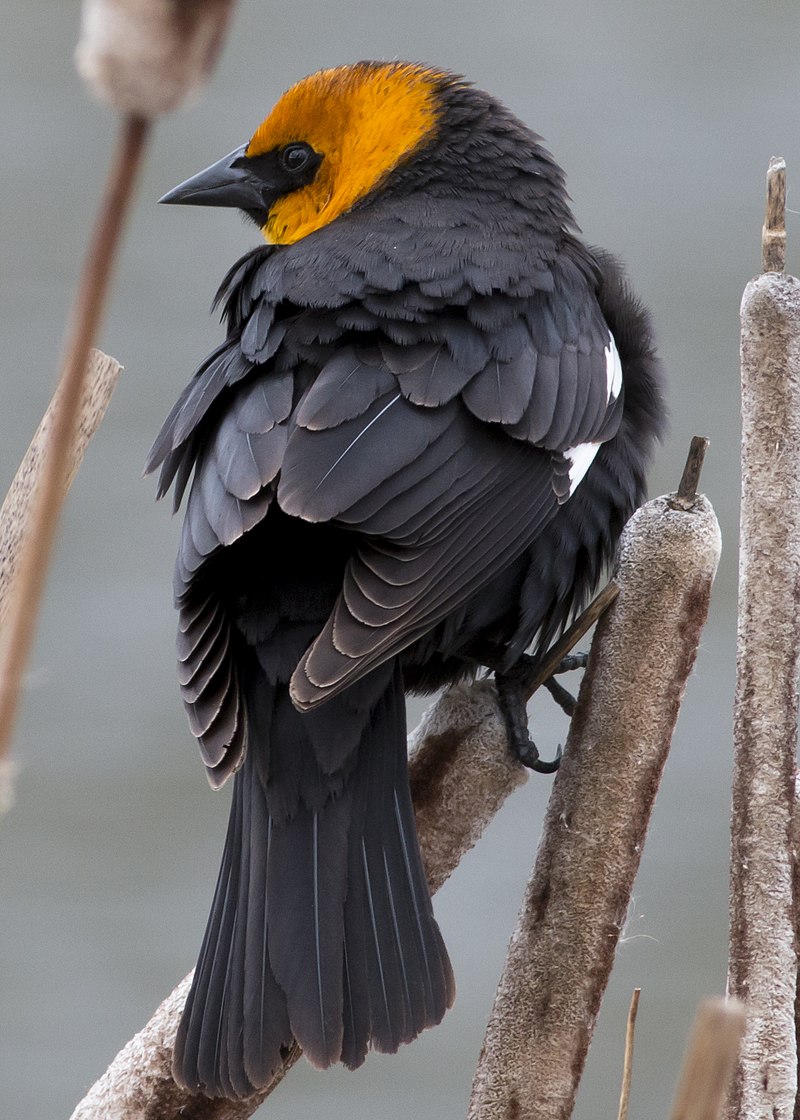
The yellow-headed blackbird is a medium-sized bird with striking features – its head and neck are bright yellow, while the rest of its body is black.
It has large eyes, a pointed bill and long wings that help it to soar through the air.
The species gets its name from Greek words meaning ‘yellow’ (xanthous) and ‘head’ (cephalus).
This species can be found in wetlands across North America during summer months where they feed on insects and other invertebrates such as snails, earthworms, spiders and crustaceans.
During winter months, they migrate southward for food or when temperatures drop too low for their comfort.
They also form flocks, making them more visible than solitary birds like hawks or owls. Yellow-headed Blackbirds make beautiful sounds that echo around wetland areas; these melodic calls bring joy to many nature lovers.
Scientific classification:
| Kingdom | Animalia |
| Phylum | Chordata |
| Class | Aves |
| Order | Passeriformes |
| Family | Icteridae |
| Genus | Xanthocephalus Bonaparte, 1850 |
| Species | X. xanthocephalus |
43. Flame Robin
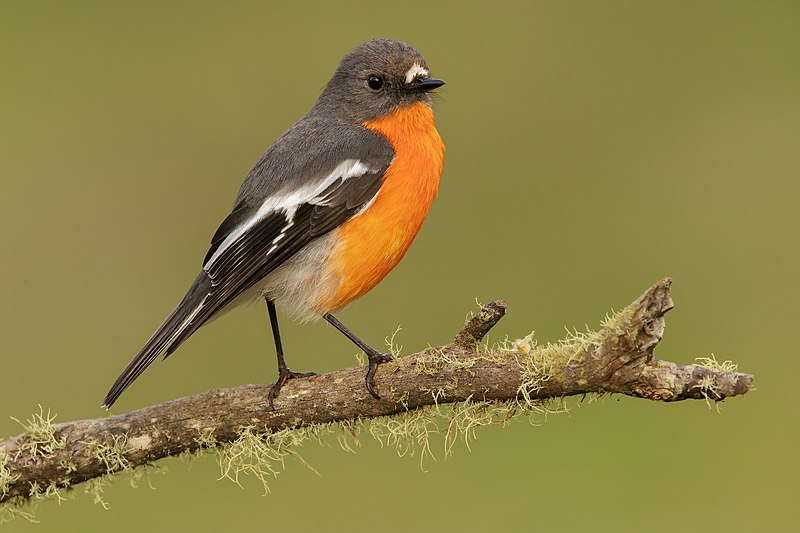
The Flame Robin is a small passerine bird native to Australia. It has bright red feathers on its chest and gets its name from the fiery coloring of these features.
This robin can be found in more excellent areas of south-eastern Australia, including Tasmania. While it’s not an uncommon sight, the Flame Robin isn’t particularly abundant either.
Its diet consists primarily of insects and other invertebrates which it finds while foraging through leaf litter or low vegetation. The species is sexually dimorphic, with males having more vibrant plumage than females.
Nevertheless, both genders have striking colors that will catch any birdwatcher’s eye.
Scientific classification:
| Kingdom | Animalia |
| Phylum | Chordata |
| Class | Aves |
| Order | Passeriformes |
| Family | Petroicidae |
| Genus | Petroica |
| Species | P. phoenicea |
Also Featured In: Birds that Live in Kangaroo Island, Common Flinders Island Birds
44. Venezuelan Troupial
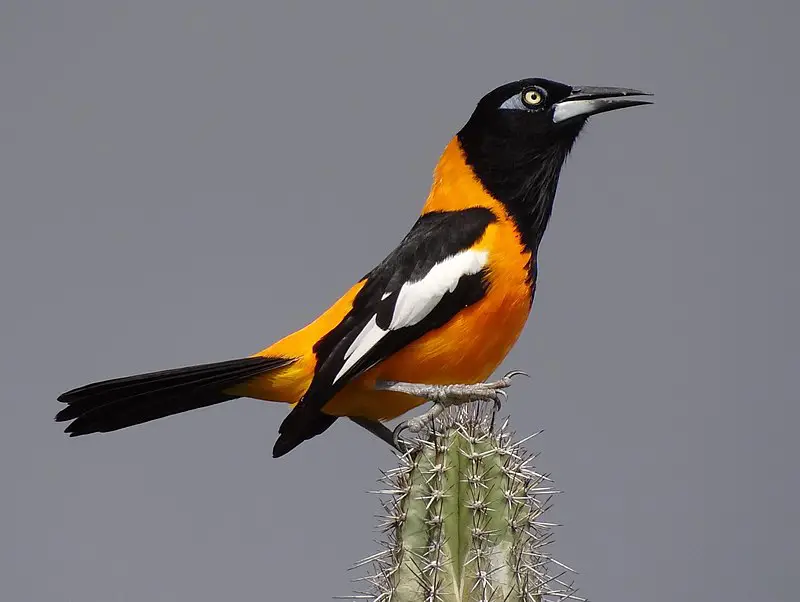
The Venezuelan troupial (Icterus icterus) is Venezuela’s national bird and can be found in Colombia, Venezuela and some Caribbean islands such as Aruba, Curaçao, Bonaire, Trinidad and Puerto Rico.
It was previously part of a superspecies known simply as the troupial with the orange-backed troupial and Campo troupial but has since been split off.
The name ‘troupial’ comes from French ‘toupiare’, which means “troop” due to their tendency to gather in flocks outside of breeding season.
They are medium sized birds with males being slightly larger than females – both have black bodies that contrast against a bright yellow head or crest.
Their wingspan averages around 35cm long, making them quite agile flyers when they migrate each year between November and April for warmer climates.
Scientific classification:
| Kingdom | Animalia |
| Phylum | Chordata |
| Class | Aves |
| Order | Passeriformes |
| Family | Icteridae |
| Genus | Icterus |
| Species | I. icterus |
45. Sun Conure
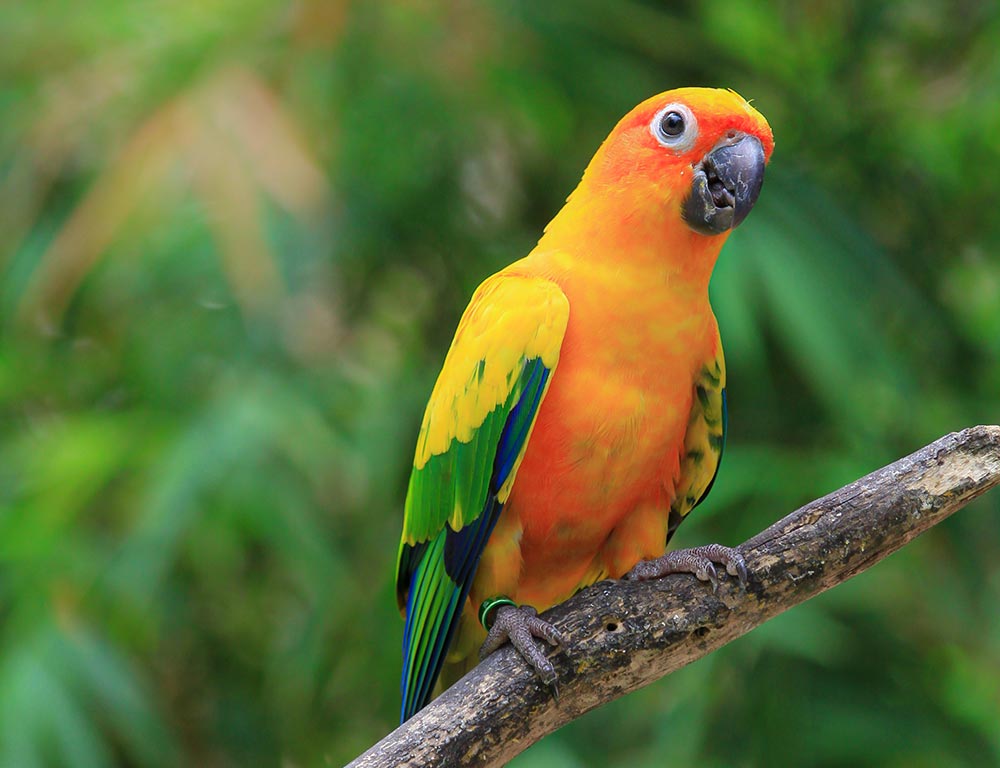
The Sun Conure is a vibrant and social species of parrot native to northeastern South America. Both males and females have predominantly golden-yellow plumage, with orange flushes under the face and wings tipped in green and blue.
They are medium-sized birds with black beaks that can make for great companions when properly cared for.
These birds love attention from their owners, so it’s important to spend quality time interacting with them on a regular basis to ensure they remain happy and healthy.
As conures go, the Sun Conure stands out due to its bright colors, which makes them popular among bird lovers around the world.
Scientific classification:
| Kingdom | Animalia |
| Phylum | Chordata |
| Class | Aves |
| Order | Psittaciformes |
| Family | Psittacidae |
| Genus | Aratinga |
| Species | A. solstitialis |
46. Kea
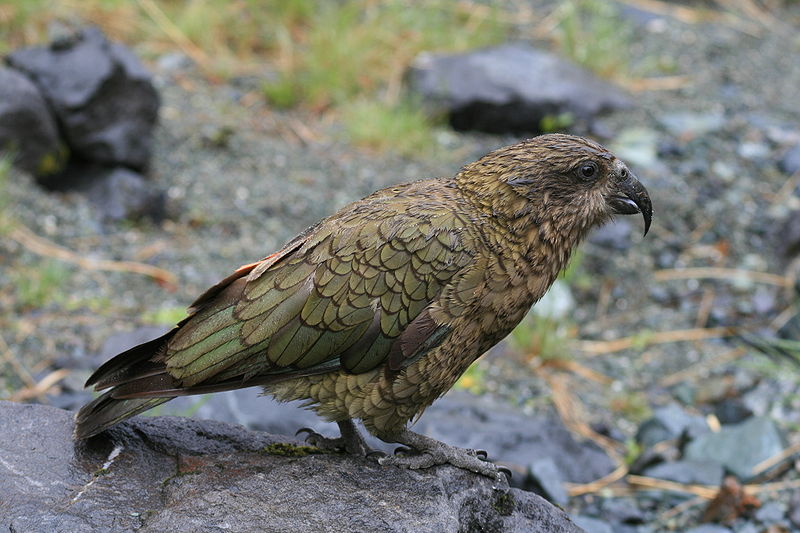
The Kea is an impressive species of large parrot found in the South Island of New Zealand. It stands at 48 cm and has a beautiful olive-green colour with orange under its wings, as well as a long curved grey-brown upper beak.
Its diet consists mainly of root vegetables but also includes carrion on occasion.
The Kea is known for being one of the world’s few alpine parrots, living in forests only below 1,200m above sea level due to its tolerance towards cold weather conditions.
It’s incredibly intelligent too; they have been observed solving puzzles and using tools. This remarkable bird makes a great addition to any nature enthusiast’s list when visiting this region.
Scientific classification:
| Kingdom | Animalia |
| Phylum | Chordata |
| Class | Aves |
| Order | Psittaciformes |
| Family | Strigopidae |
| Genus | Nestor |
| Species | N. notabilis |
Conclusion
The 46 birds of Orange County reflect the region’s diverse and thriving ecosystems. Ranging from coastal wetlands to urban parks, these birds demonstrate remarkable adaptability and ecological significance.
Species like the Elegant Tern and the California Gnatcatcher highlight the unique coastal and chaparral habitats, while migratory birds such as the Allen’s Hummingbird exemplify the area’s role as a vital stopover point.
The presence of these birds is a barometer for environmental health, emphasizing the need for continued conservation efforts.
Protecting their habitats not only benefits these avian species but also enhances the ecological richness and beauty of Orange County, contributing to the well-being of all its inhabitants.